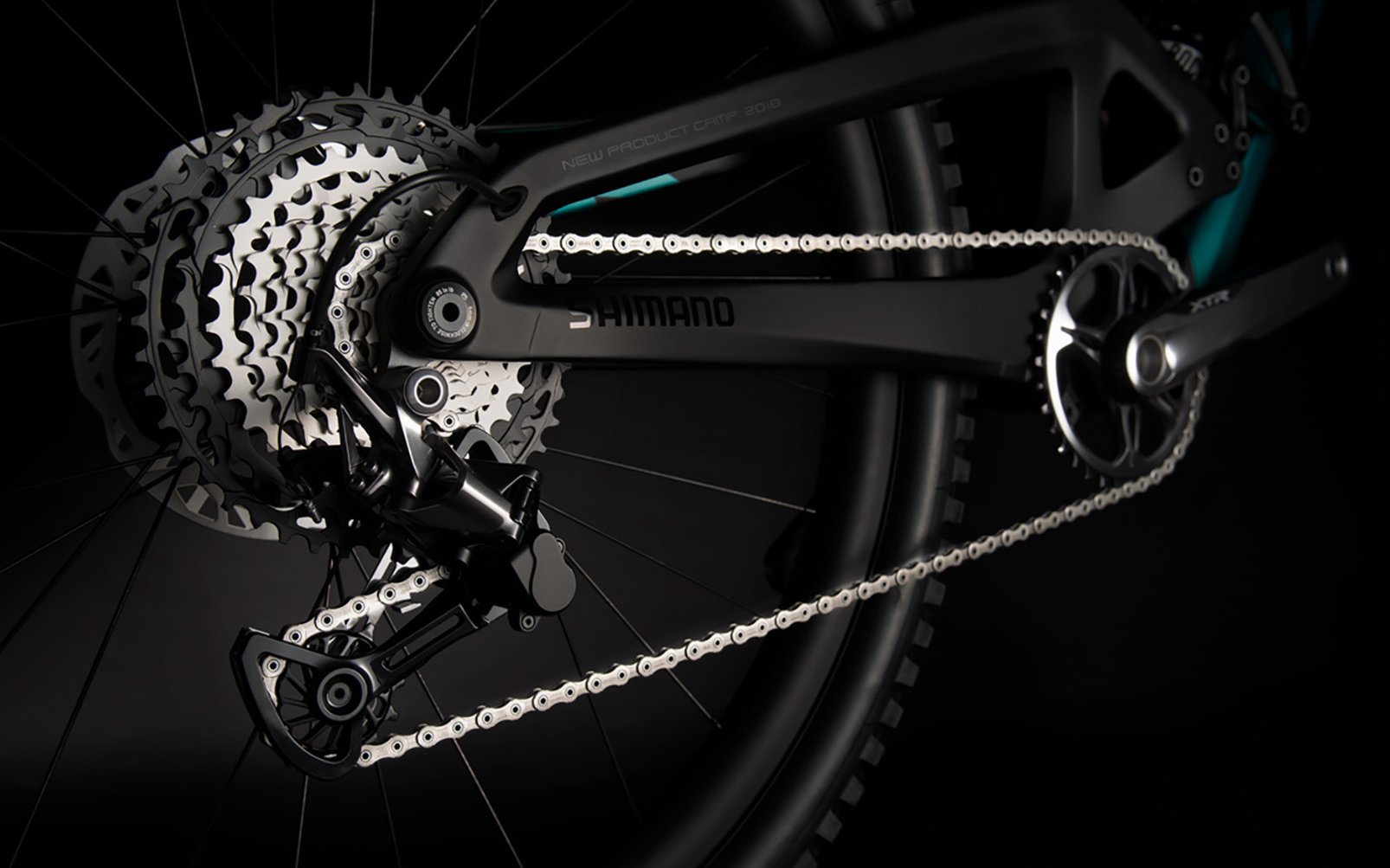
Hands on Product Intro
2019 Shimano XTR 9100: 10-51 12spd is Here
Nick Murdick, Shimano’s MTB Product Manager, reminded us from the outset; the R in XTR stands for Race.* Someone** sitting near me muttered, “then what does the XT stand for?” That question never got answered but the tone in the room made it clear that Shimano is serious about regaining lost ground. What was stressed however was that engineering and design decisions were decided with one criterion; “what’s best for the racer.”
*Race in this case refers to two distinct disciplines; enduro and cross country. The biggest difference between the two component groups is brakes but there are a few other options that can distinguish between the two.
**I think it was Jason Sumner from MTBR***
***Milking the footnotes from the outset
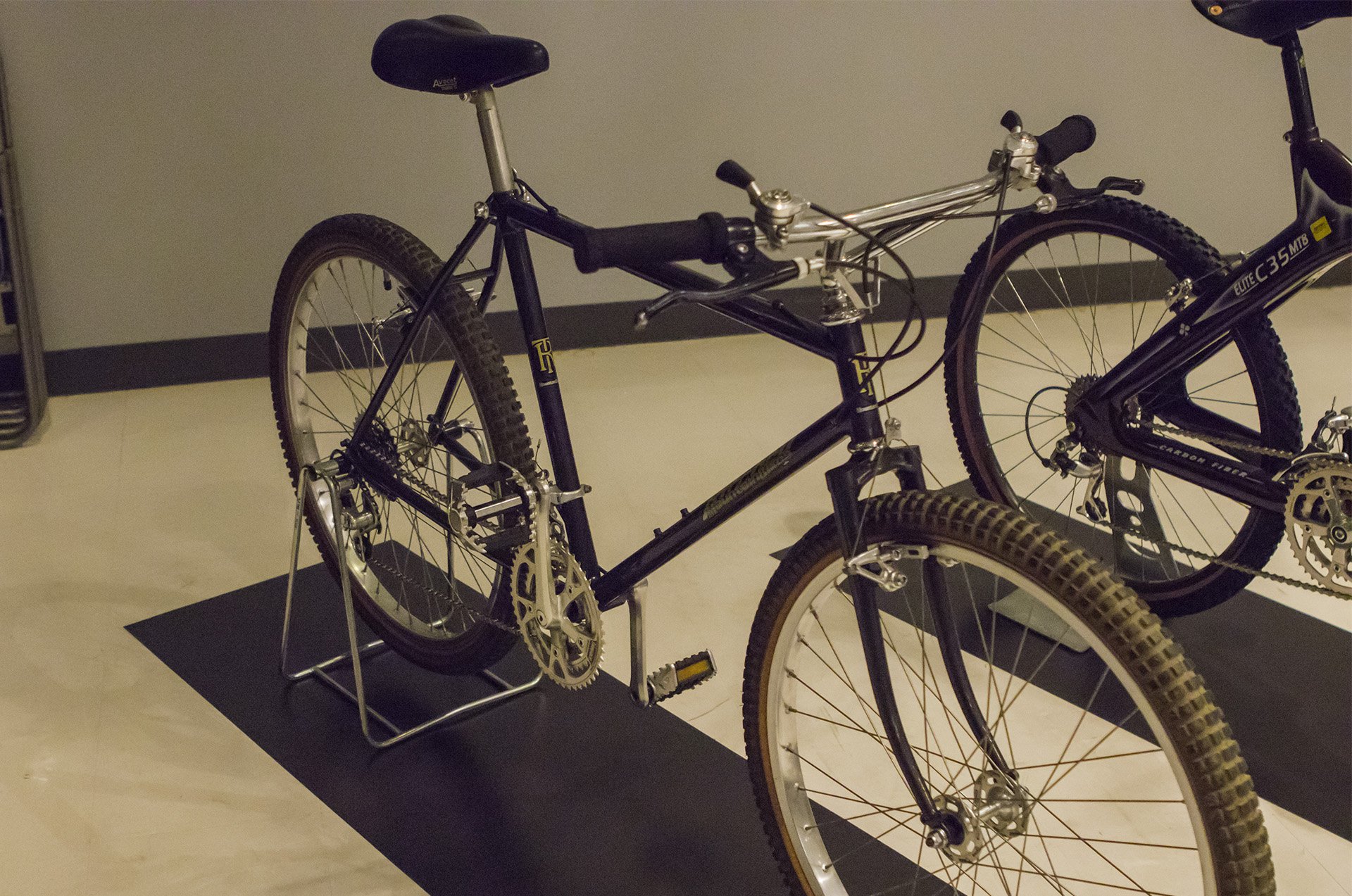
Every XTR group was on display, and even the first offload group ever, Deore XT from 1983. My first bike was almost identical to this early 80s Ritchey. I still have it but few of the original components remain. Photo - Cam McRae
If you have shopped for a new trail or Enduro bike lately, particularly one that is anywhere from middle to top end, there is virtually no chance it was adorned with anything but a version of SRAM’s Eagle drivetrain. There are apparently still some Euro brands who spec. 2X drivetrains, and maybe a few choosing to use Shimano’s 1X in 11sp, but it seems at this point that those are mostly a rounding error away from nada. Eagle has taken over; it’s lighter, easier to use, provides excellent chain retention and durability and the range is more than adequate in most situations. It has been, in short, unbeatable.
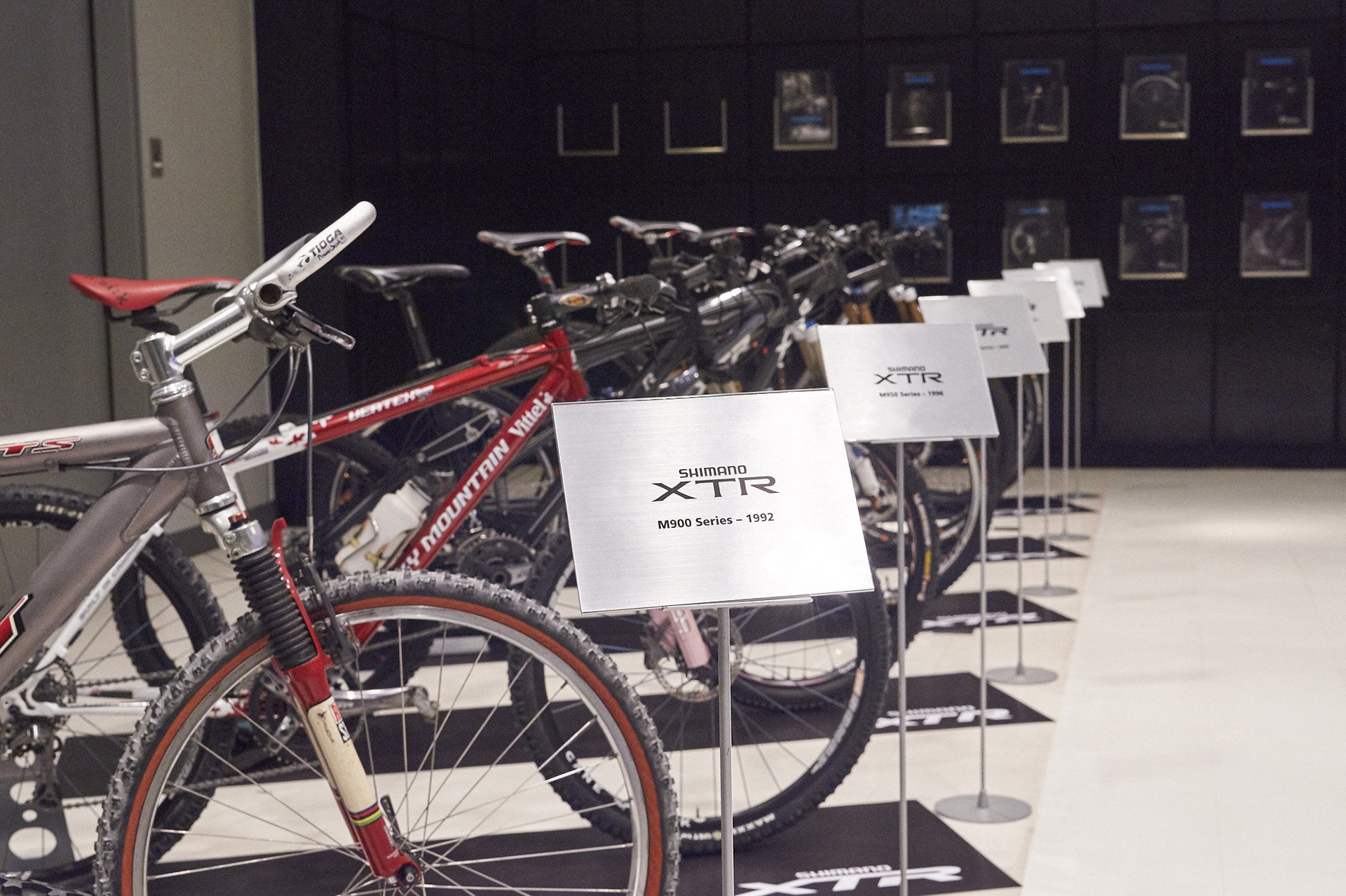
All the XTRs. I think the first one, from 1992, was my favourite on display.
Shimano is unaccustomed to playing second fiddle and even less used to being behind in the tech arms race. What I'm getting it is that there is a lot riding on this latest version of the company’s flagship component group, which is why seven of us North American journalists were flown to Osaka to tour the factory where these very parts are built, lay our hands on the metal and quiz the staff from both Japan and North America about the new bits.
My XTR crystal ball was a little cloudy. I knew Shimano’s response was going to attempt to put XTR back in contention, which meant a wide range 12sp 1x drivetrain was essential, but there were some roadblocks. The first was the XD driver which accommodates a 10t cog to achieve adequate range. I know that Shimano doesn’t follow if they can possibly avoid it and that adopting a standard developed by SRAM wasn’t in the cards, so I was certain we wouldn’t see an XD driver body. The other hurdle was chain retention. Unlike the XD standard, which became open source after the first year or so, SRAM has initiated legal action against several chainring manufacturers who built rings with an alternating tooth profile similar to SRAM’s Narrow Wide technology. Building a new driver body is one thing, but I couldn’t see an adequate alternative to the effectiveness of narrow wide. It does wonders for chain retention and consistent chain alignment (without narrow wide, chains notch back and forth slightly unless you are in the middle cogs) and it’s quiet and durable. Shimano responded earlier with longer tooth profiles but this was only a half measure.
The (SRAM) XD compatible driver body design is an open standard available to any hub manufacturer interested in producing a driver body compatible with the XX1 10-42 11-speed cassette (or current Eagle cassettes - Ed.). This open standard allows hub manufacturer to design an XD compatible driver body that works with their own ratchet design. - From SRAM literature.
Game On
When the curtain was drawn back there were no gasps. Rumours of a 10-51 cassette were accurate and, as expected a brand new driver body makes way for a 10t smallest cog. Micro Spline is Shimano’s solution to the 10t problem and we were told there were other obstacles preventing adoption of the XD solution. Shimano doesn’t produce a one piece cassette* and I was told it was unlikely Shimano would get permission to use SRAM’s intellectual property.** SRAM’s literature, quoted below, tells a different story. Redesigning the cassette would have been required, but that it seems to me that would be only slightly more than trivial for a company with Shimano’s manufacturing and engineering superiority. But perhaps there are intellectual property hurdles as well.
*the cassette can have more than one piece using an XD driver, as evidenced by e*thirteen’s solution, but once installed the pieces must attach and form a single unit because most of the length of an XD driver body is not splined.
**"The XD compatible driver body design is an open standard available to any hub manufacturer interested in producing a driver body compatible with the XX1 10-42 11-speed cassette (or current Eagle cassettes - Ed.). This open standard allows hub manufacturer to design an XD compatible driver body that works with their own ratchet design.” From SRAM literature.
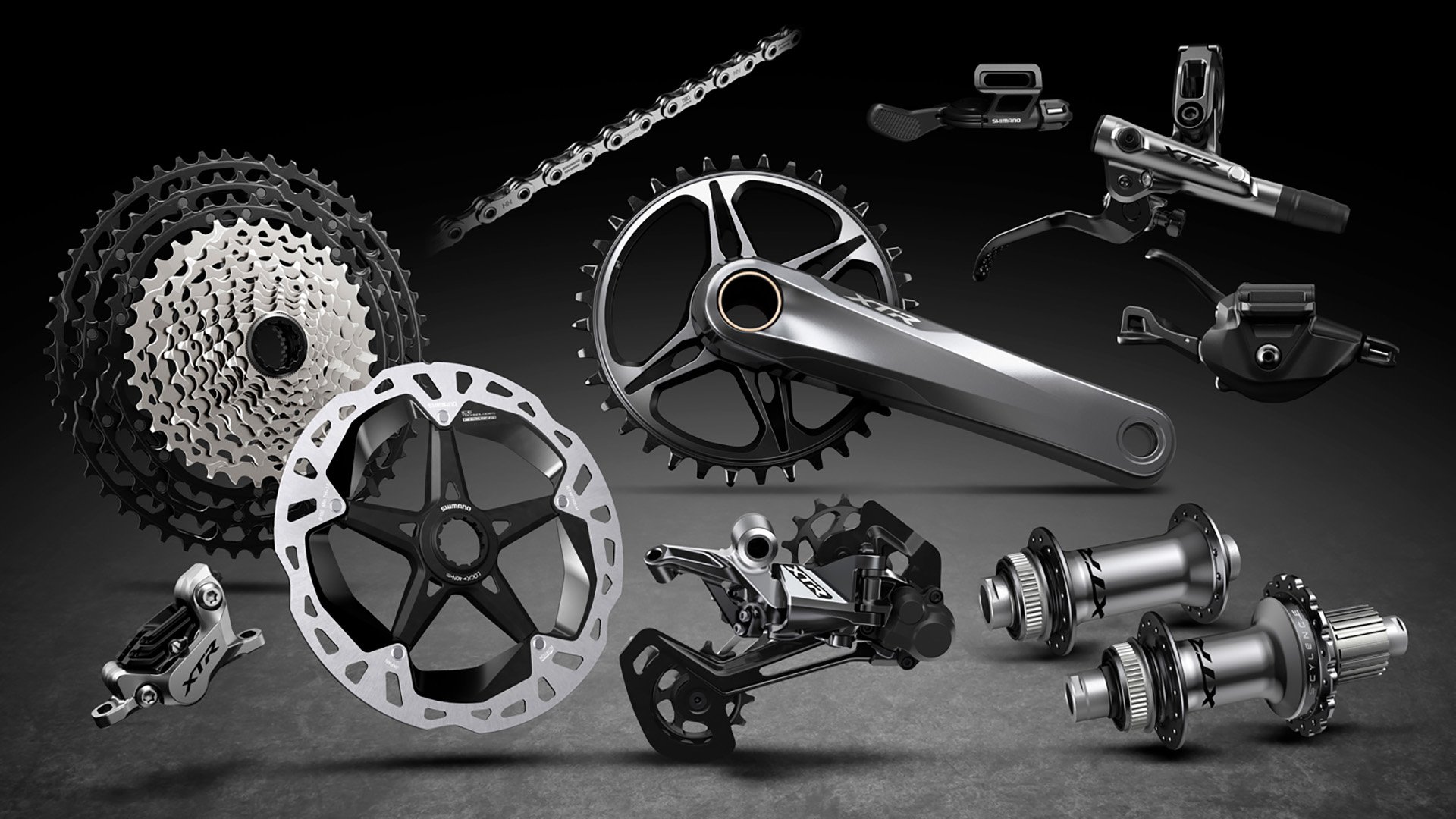
This is the 12spd Enduro Group. Scroll to see the differences between the three groups. A collection that included 2x options was not included.
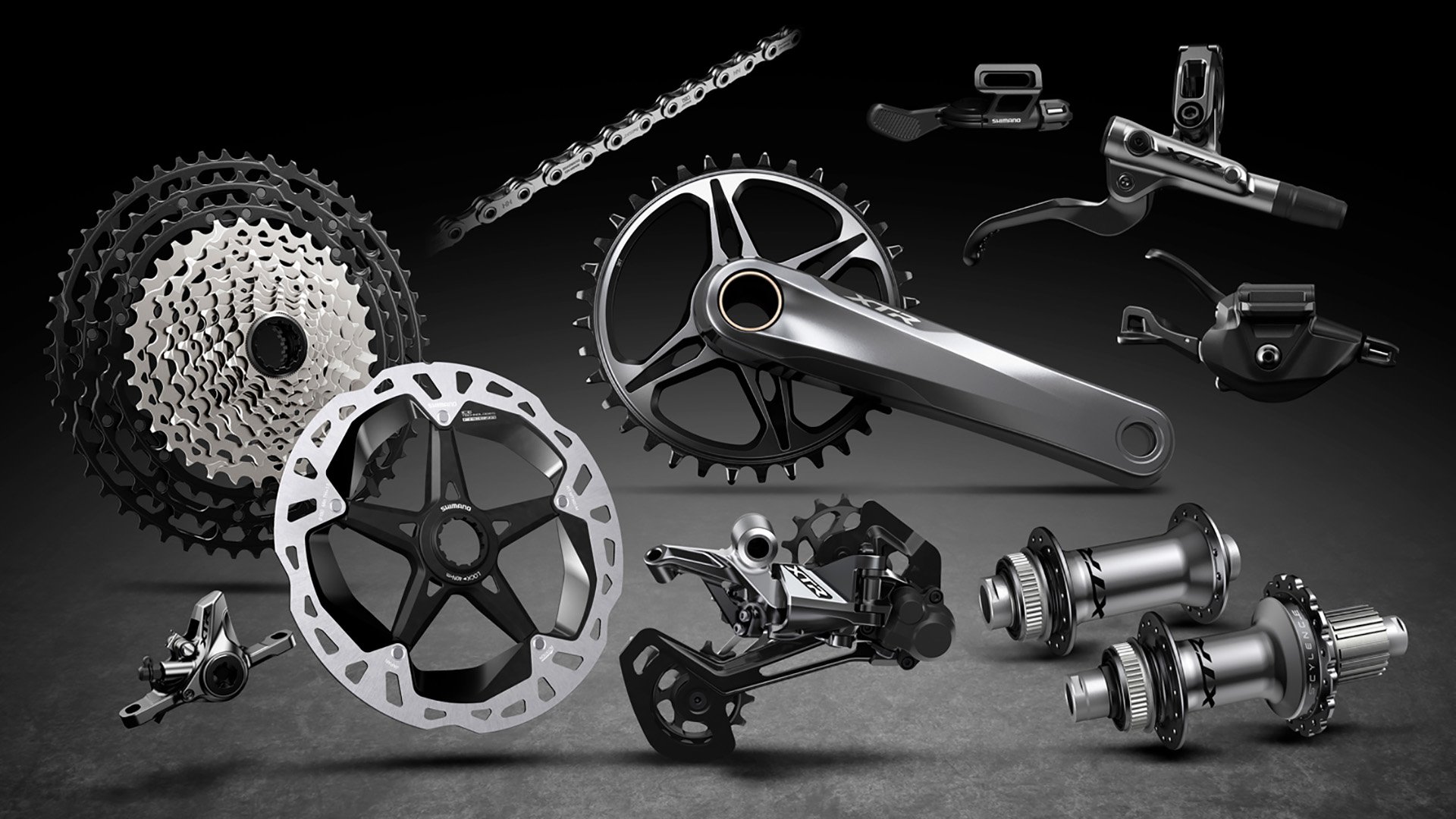
The 12 spd XC group.
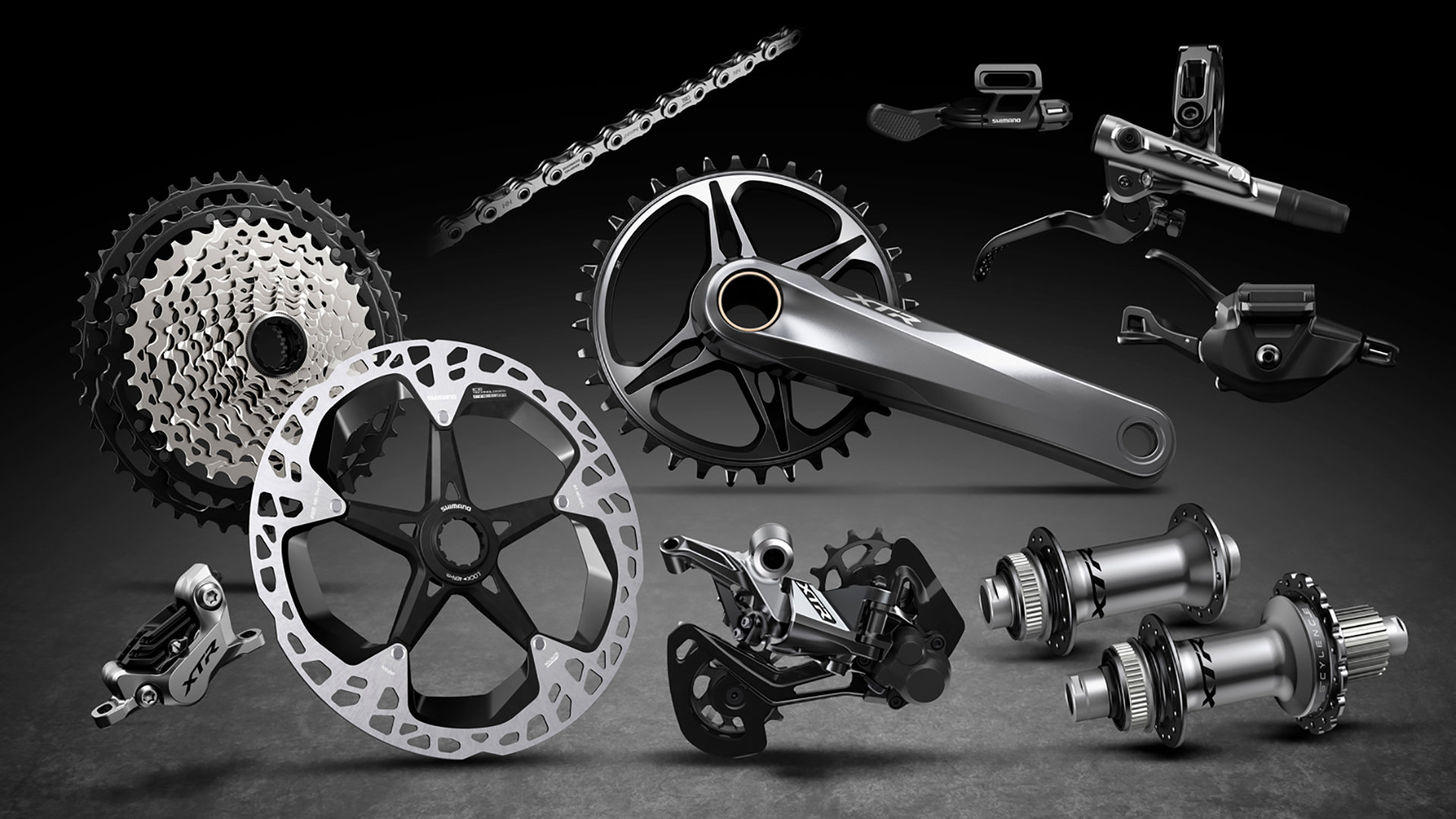
The 11spd group with an Enduro bent.
So the biggest disappointment of the entire group is that (for now at least) Shimano will not license or open source the Micro Spline interface to allow other companies to develop Shimano-compatible hubs. With one exception, any wheels you own now will be incompatible with Shimano 12spd. That exception is DT Swiss hubs. DT was involved with Shimano’s development in some undisclosed fashion (likely on the SCYLENCE freehub - see below) so DT was allowed to develop a driver. In fact DT has an advantage over Shimano because the Swiss hubs will be backward compatible for XTR 12spd while Shimano has no plans to create a kit to retrofit current generation XT, Saint or XTR hubs to allow Micro Spline installation.* This means that, while you could purchase an XTR drivetrain in the after market, you’ll only be able install it if you purchase 2019 Shimano or current generation DT hubs or if you already have DT hubs. Otherwise those are some pricy paperweights.
*I was told one reason for this was that Shimano has very little current hub market share - around 2%. It seems to me that number still represents thousands of riders the world over who may wish to get their 12spd on Shimano-style.
Hyper Glide+
Moving on to the XTR 9100 drivetrain, Shimano has made some interesting moves. The first is a significant advance to Shimano’s proven Hyper Glide system. HG refers to the ramps that give your chain a boost when you shift into a larger cog (lower gear). This system has been copied by virtually everyone and it makes Shimano drivetrains shift incredibly smoothly - in one direction. This wasn’t enough however because Shimano wanted HD to work both ways. Shifting to a smaller cog is generally easier because gravity is on your side and you are likely accelerating, but Shimano has racers in mind and while smoother shifting is nice, keeping the power down longer is the main goal and the rationale for Hyper Glide+.
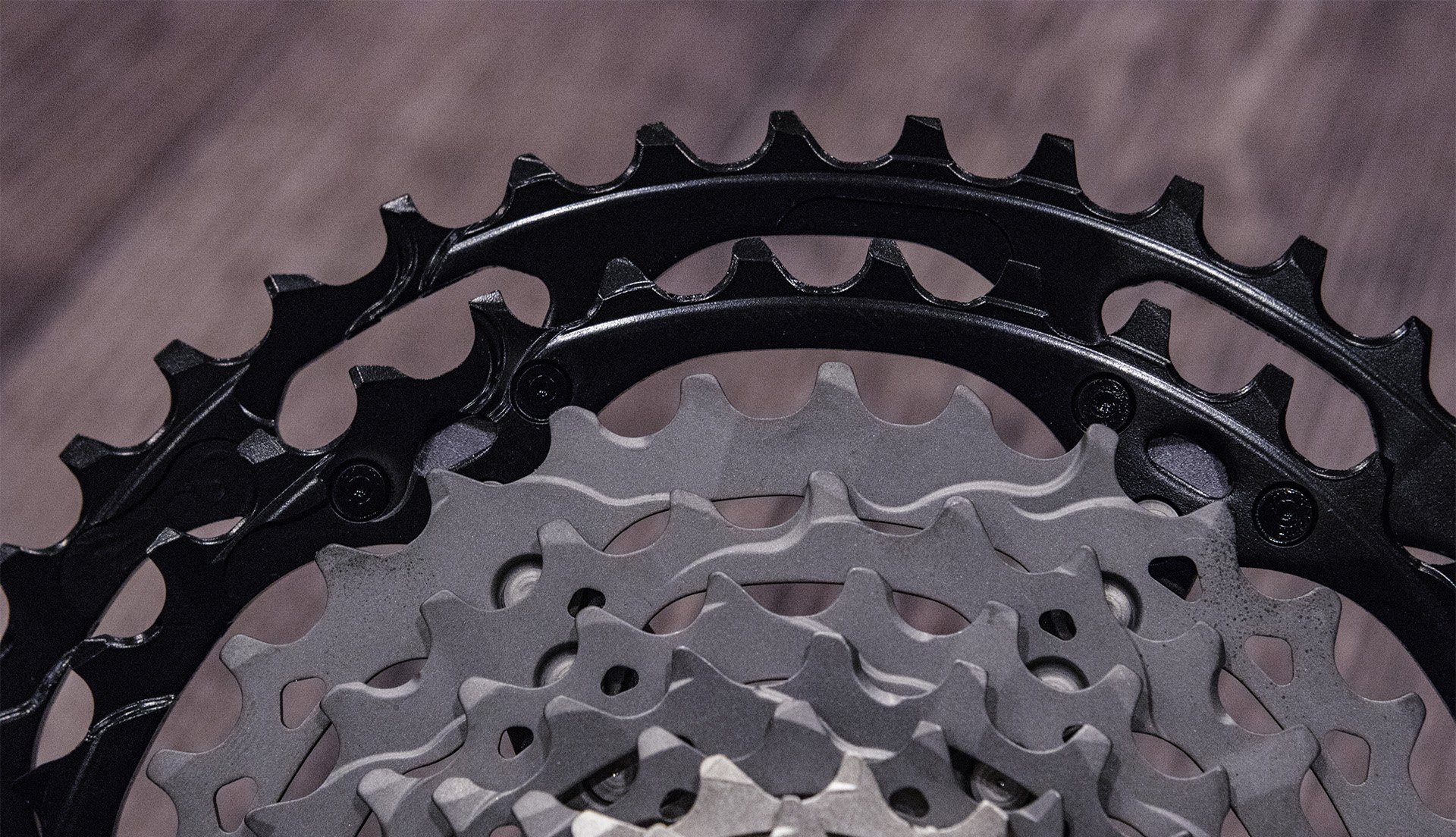
It's hard to find two teeth the same on a particular cog, such is the complexity of tooth profiles on a HG+ cassette. As MTB product manager Nick Murdick told me, many teeth have multiple jobs, and that's not counting driving the chain. Photo - Cam McRae
How does Hyper Glide work?
One factor to consider in order for Hyper Glide to work properly is cog spacing.There will be points in the interface between two cogs where teeth line up perfectly. Hyperdrive won’t work here because a gap smaller than the distance between two teeth is desirable for a shift, so ramps have to be aligned at specific intervals. Thanks to gravity holding the chain on the smaller cog, it is virtually always successful moving inboard, unless you decide to override HG by putting more pressure on the shifter (this is particularly important if you are climbing something steep and can’t wait for half the cassette to rotate before for your shift.)*
*Rapidrise (aka low normal) was designed to ensure Hyper Glide would work every time because spring tension rather than cable tension generated from your thumb determined how much force was applied to the derailleur when moving to a larger cog. But as mentioned above, there are times when it’s desirable to override Hyper Glide and this was impossible with Rapidrise. This was one reason for its demise.
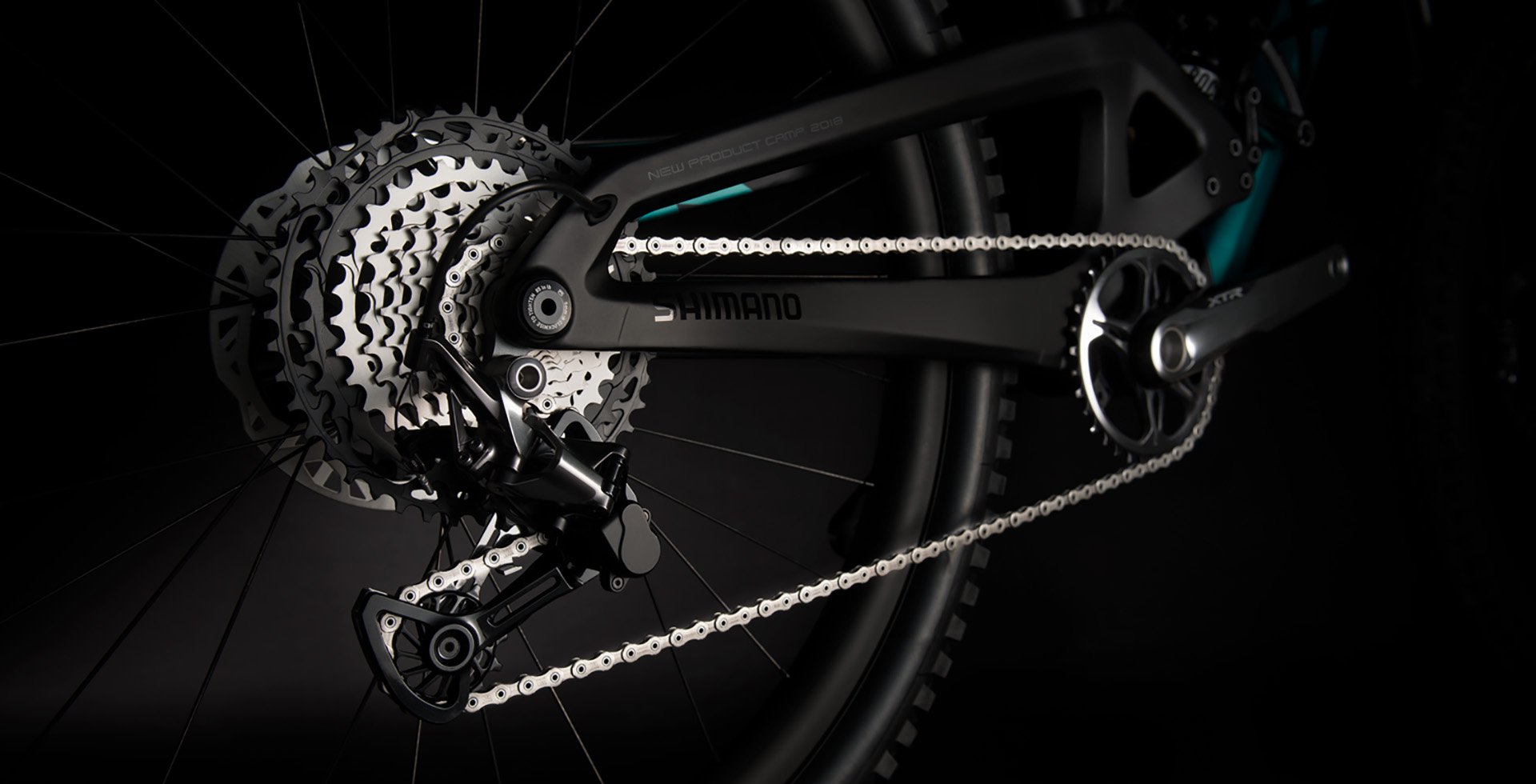
The 11spd version of XTR 9100 getting ready for some two way hyper gliding.
Back to Hyper Glide+
Hyper Glide+ is more challenging and we were told that Shimano has been working to perfect this technology for years. Because upshifts (into smaller cogs) initiate more easily and don’t have to grip anything to ‘climb’ to the next cog because of the pull of gravity, it stands to reason that hitting the Hyper Glide+ down ramps could be more challenging. As a result tooth profiles needed to be modified to resist the shift slightly in areas prior to and after ramp locations. Nick Murdick explained this to me in some detail;
“So to get a nice smooth transfer of driving force from a larger cog to a smaller cog, it’s a matter of making sure that the chain doesn’t let go of the larger cog until it rotates out of the way. The chain shouldn’t be able to follow the inertia of the chain and jump down prematurely. We needed to make certain teeth that could hold onto the chain very well – like the opposite of a shift gate. Not only is that hard to do in itself, but there are many teeth that have multiple jobs. And of course the holding teeth can’t stop doing their other jobs or some other part of shifting will suffer.”
This was part science and part trial and error involving athletes and engineers working together in the field. Nick went on to explain how this process went:
“Through the rounds of prototype testing our riders would report something like ‘I got maybe 20% hyperglide outward shifts.’ Through the rounds of prototypes, that percentage grew as we made little adjustments to the tooth designs. Watching our engineers mark a tooth with a marker and then file in a tiny adjustment that you could feel during the next ride was awesome. We all stared in disbelief as he handed it back and it went out for another lap. Upon return though, ‘Ok that got me to 50%. Whatever you did worked.’”
Nick took me down the rabbit hole some, talking about which teeth bear the brunt of the load at any given moment but the take home was that this addition to Hyper Drive allows riders to get the power down more seamlessly when it’s needed most, and that it works best during the biggest efforts. Rather than having the chain whip to the smaller cog abruptly and with a clunk it stays on the leading teeth of the larger cog until the wheel rotates far enough to release it. Nick thinks we’ll be impressed when we get to try it in Crested Butte in a few weeks and I’m looking forward to scrutinizing the system.
Chain and Chainring
One of the real benefits of SRAM’s 1x technology has been superior chain retention. While riding Eagle or 11spd SRAM 1x drivetrains I have rarely dropped my chain. In fact I can only recall two times in total over several years - and one was a crash. Shimano knew that to compete with Eagle this chain security needed to be reproduced, and one change made to address this was an alternating tooth profile. By alternating I mean that the tooth that mates with the inner plates of the chain is narrower than the tooth which mates with the outer plates; narrow and then wide. This one puzzled me. I quizzed the blue shirts in attendance about the legal implications of this, considering SRAM has aggressively protected their Narrow Wide design, but was assured that Shimano would never make a move like this if there was any concern at all about a legal challenge from SRAM.*
*Actually I didn’t hear anyone from Shimano utter the other S-word. SRAM seems to be Voldemort for Shimano. TBF that seems true for SRAM as well.
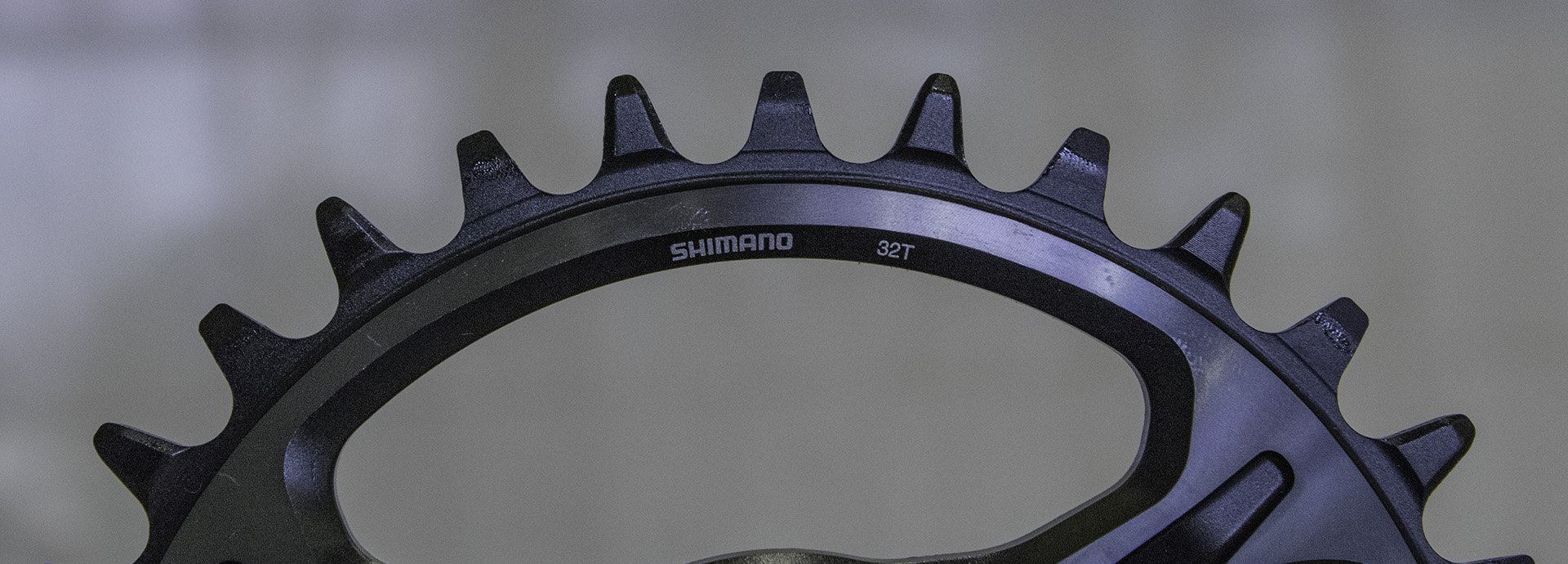
Nobody from Shimano wanted to talk too much about the tooth profile of the new chainrings but, they clearly alternate between narrow and wide. Hopefully this won't result in some prolonged legal dispute between SRAM and Shimano because riders never seem to benefit. What if companies donated more cash to trails instead of shovelling Benjamins to lawyers? Photo - Cam McRae
Oddly there is no name for the new tooth profiles and Shimano only seems to talk about the new chain with which it mates. In fact there isn’t even a mention that the chainrings have changed at all in the press release linked below; simply the image you see below. We were told about Dynamic Chain Enhancement during our presentation in Japan, but this didn’t make it into the final release that was sent to all media outlets.

The new chain and the new chainring with changes highlighted.
Shimano does however talk about the new chain, which gets credit for the reduced vibration that occurs when the chain alternates from an inner plate link to an outer plate link as it meets the chainring. The inner link plates extend further into the cavity between the outer plates (see graphic above) improving tooth contact in concert with the alternating tooth profile (although this change was given none of the credit). XTR chain pins have been ‘chromized’ for some time but now the inner link plates are given this treatment for greater hardness and durability. Finally, there is now a reusable quick link. Hooray!
Cassette and Freehub
The cogs for Shimano’s new XTR cassette are produced with three different metals. The three largest cogs are made of aluminum, the next five are titanium and the final four are steel. A new anodizing process allowed smaller aluminum cogs to be used for weight savings. The cassette is said to weigh 367g which is comparable to Eagle X1. There is a new beam spider construction, which looks a little like the old beam spider construction. Except this one goes to 12. You can choose between the wide range 10-51 cassette and a 10-45 ‘Rhythm Step’ with ideal steps between gears. There is also an 11spd option, but more on that later.
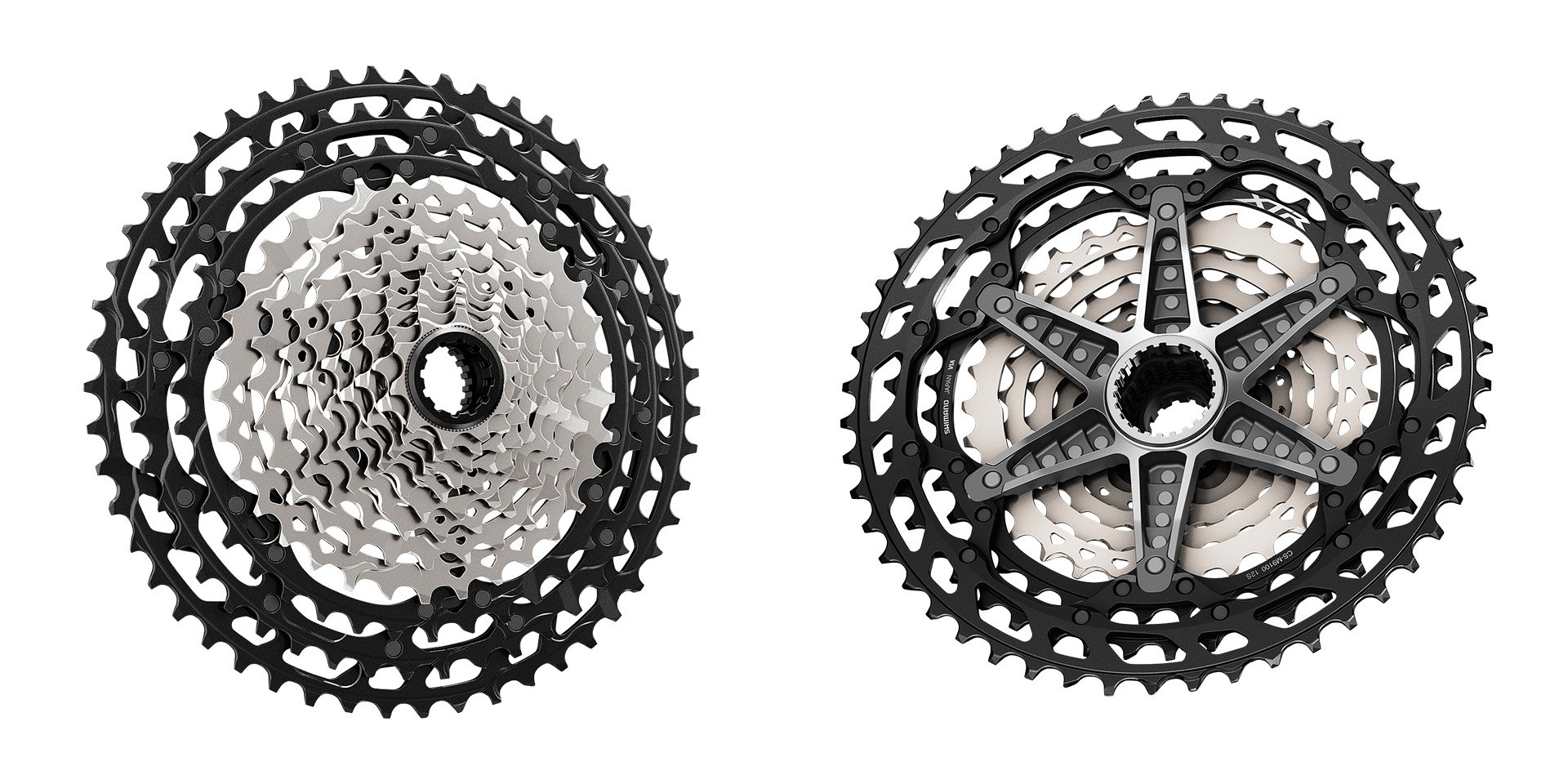
More aluminum and a new spider got the weight down into Eagle territory.
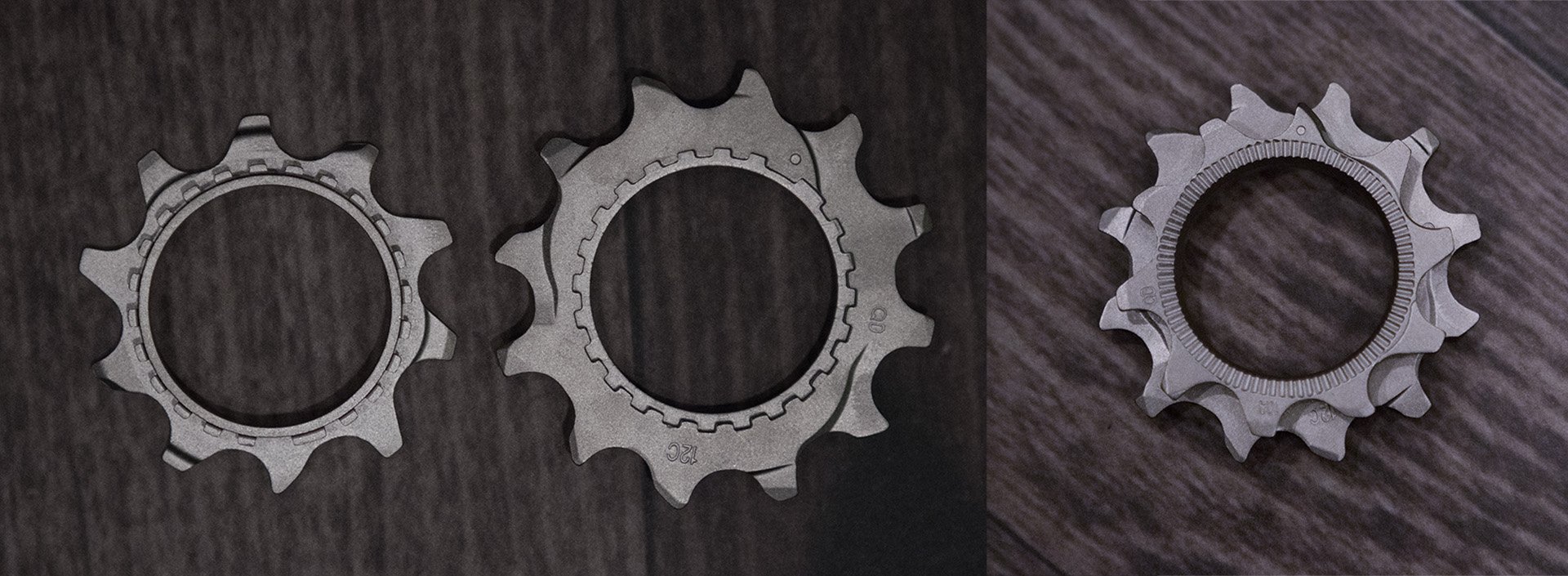
The last two steel cogs nest together with a splined interface,. The 10t cog is too small to fit around the Micro Spline driver body. Photos - Cam McRae
The biggest change to the freehub is that ratchets and pawls have been banished. Shimano has gone to a system that involves two driver plates that mesh when power is applied but then disengage completely once you lift off the gas, with help of a spring and helical splines. The new system is called SCYLENCE. Who knows why , but the system doesn’t make any noise at all when freewheeling.
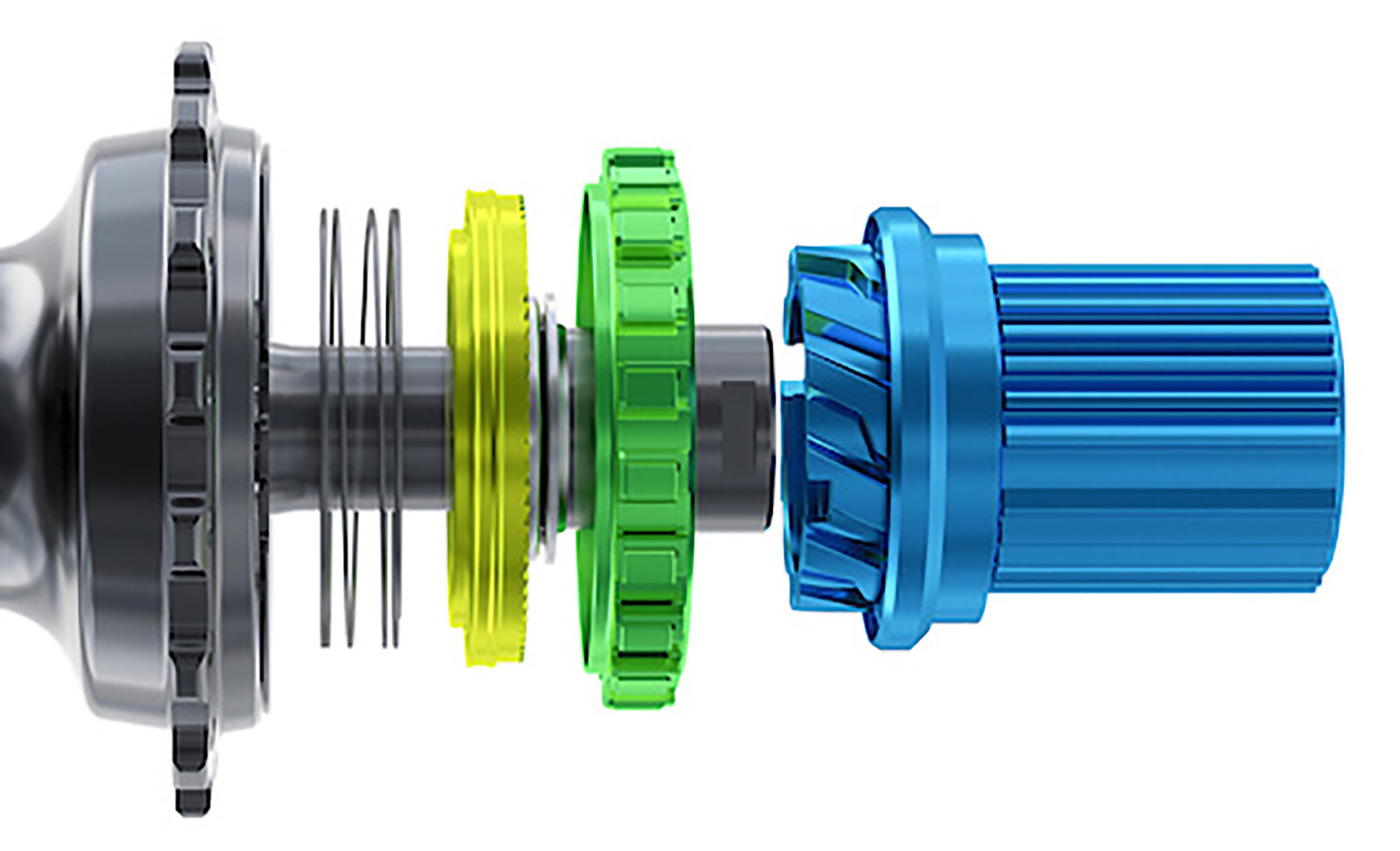
This will clear everything up! The SCYLENCE system is a bit of genius from Shimano. It's surprisingly simple and the connection when under load locks completely, meaning there are no pawls to fail. Once the wheel begins to spin freely the interface disengages making the system silent.
Engagement isn’t going to impress any of the rotation nazis at 7.6º but I’m engagement agnostic. I need those 7.6º of rest. Rolling resistance should be reduced though considering the moving portion of the hub and the stationary portion do not make any contact once disengaged. The driver body is entirely aluminum and we were told the Micro Spline design will prevent the cassette from cutting into the splines.
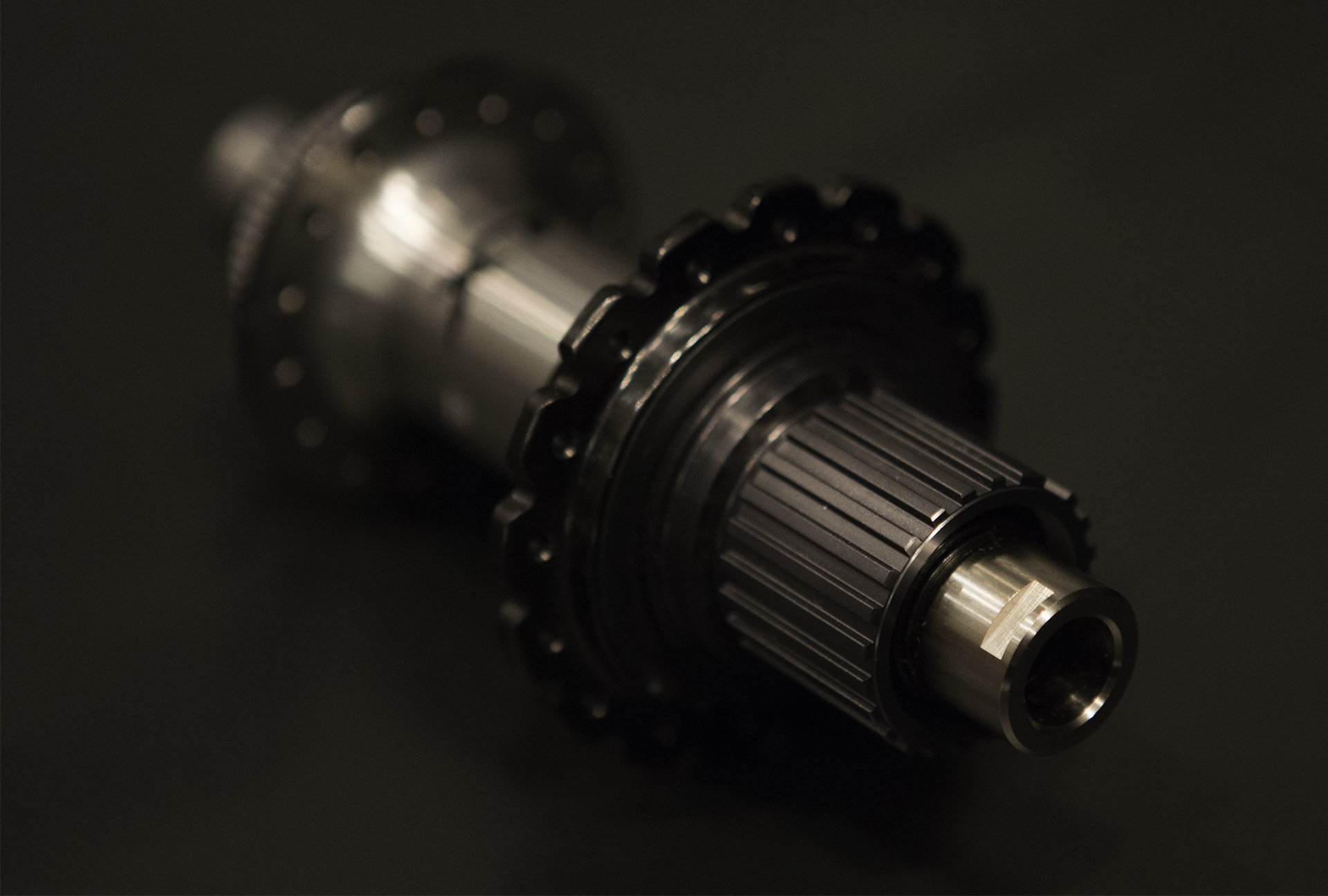
Micro Spline - the driver body is aluminum for gram savings. Photo - Cam McRae
Hubs
Shimano wants to sell entire component groups to bike manufacturers and it’s clear the company put more effort into hubs than usual. There are XTR level hubs in both J-bend and straight pull and MT900 level hubs in both configurations as well for around 250 USD vs. 500 for XTR. You can get boost or non-boost as well. The rear hubs have offset flange widths for more equal spoke tension and the large flange side has smart cutouts to ease lacing of the non-drive side. All the hub details can be found either on the image containing pricing and weights or in the embedded PDF.
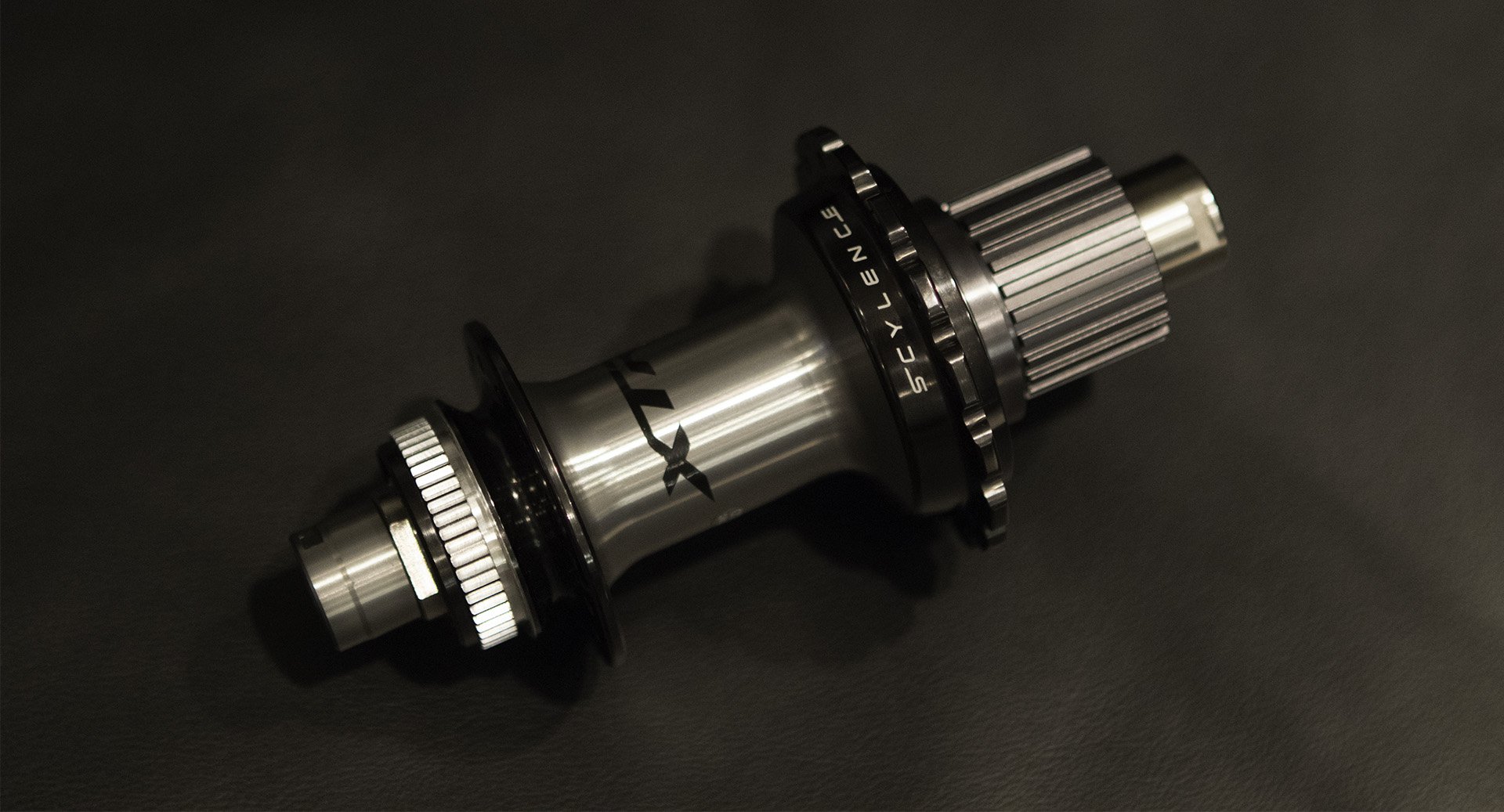
I really like the look of these hubs. The straight pull version isn't as easy on the eyes. Photo - Cam McRae
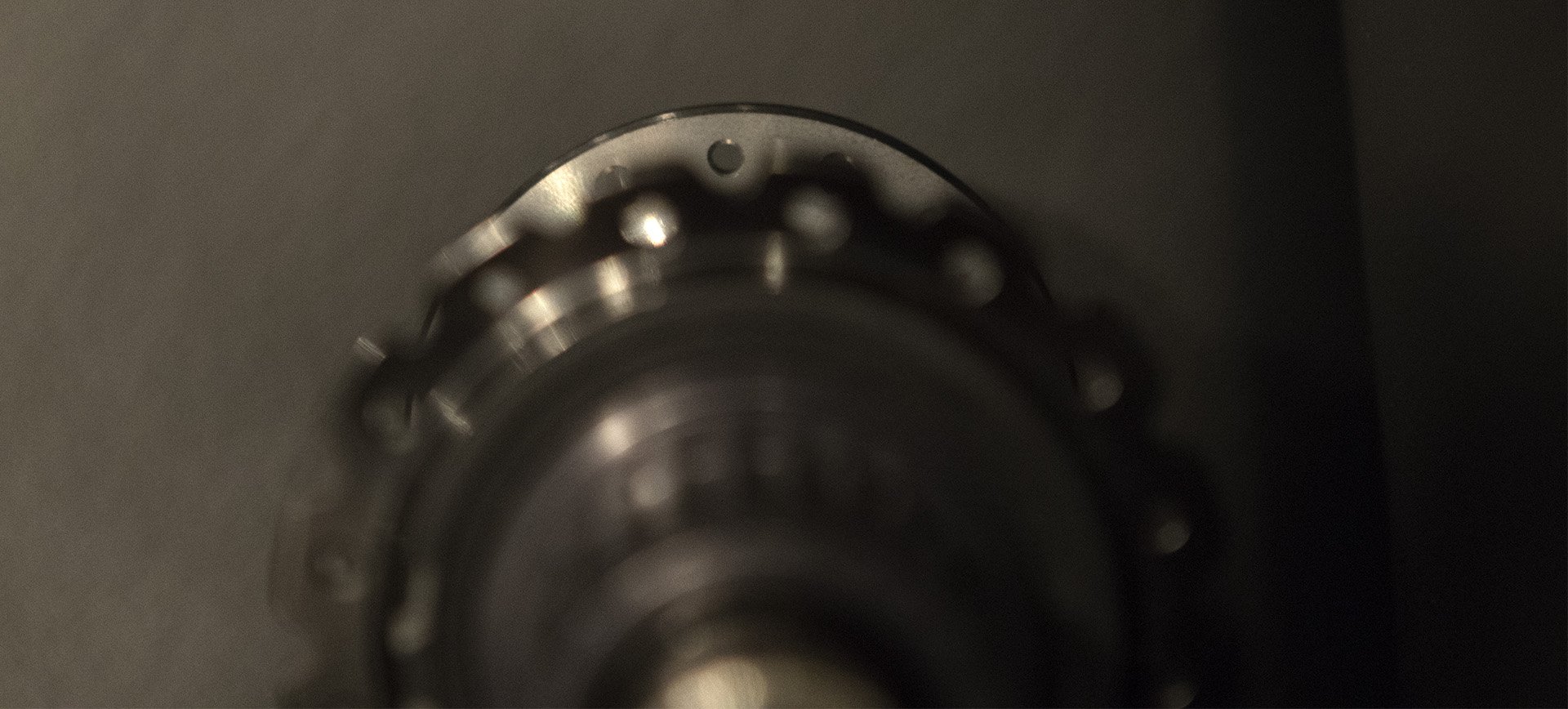
If you have ever built a wheel you'll know what this channel is for (if you haven't it's to make lacing the non-drive side flange a little easier). Photo - Cam McRae
Cranks
The new cranks are direct mount for 1x and if you are purist, you can spend more money and buy a double - although the two are swappable. These are good looking components with smooth lines and a ‘spider’(which is actually simply the spokes of chainring) that is reminiscent of early Dura-Ace. Racer Q-factor is 162 or 168 for everyone else. There is no longer any pinch bolt for the non-drive crank arm; it’s one bolt on and one bolt off. Chainline is 52mm for both 142 and 148 Boost hubs.
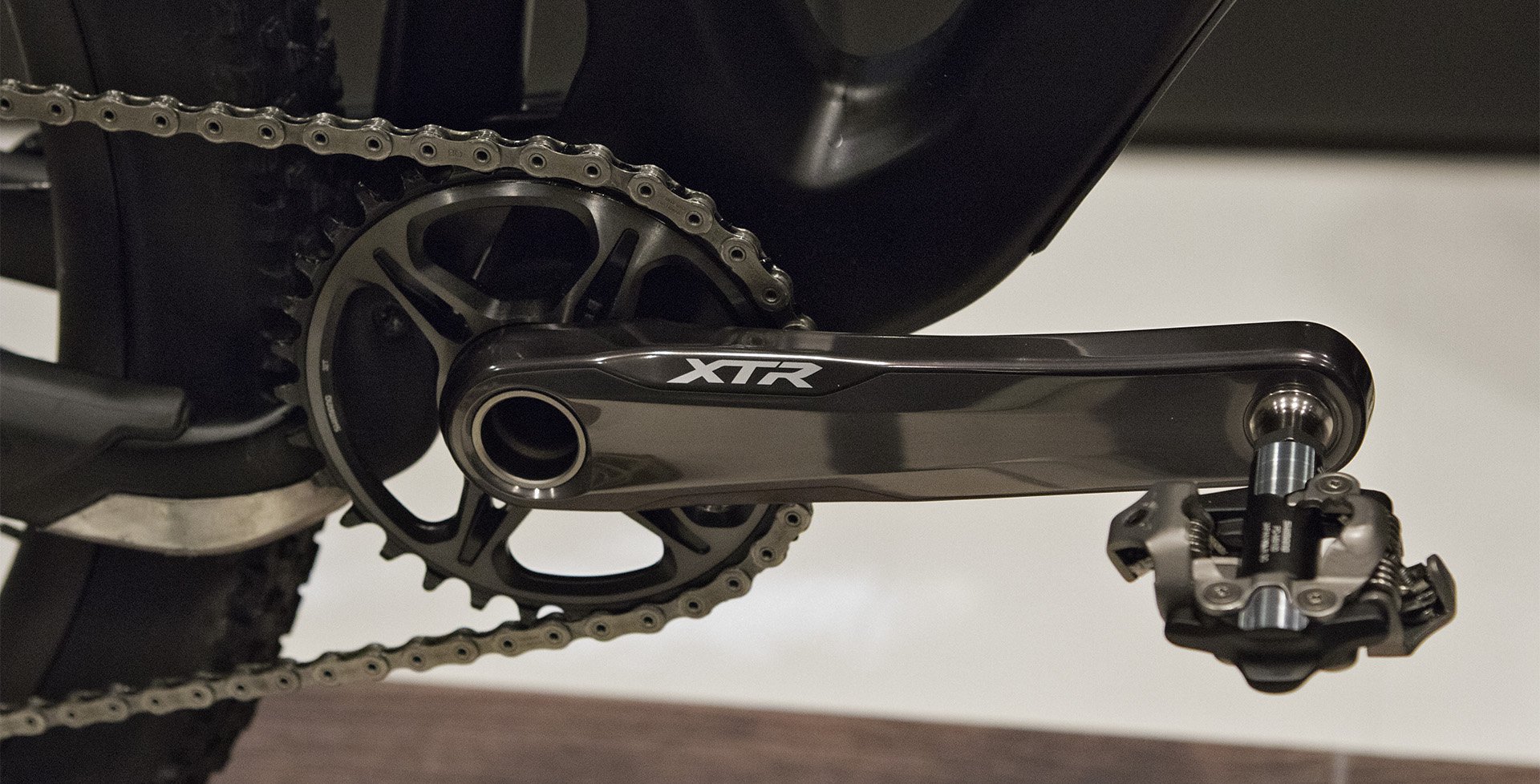
These are some of the prettiest cranks I've laid eyes on. I couldn't find a spot with decent lighting to shoot them, but take my word for it. Photo - Cam McRae
Rear Derailleur
There are three rear derailleurs of course. Because Shimano. One is for 2x, one for max 51t cogs and one is a 28mm shorter cage for max 45 tooth cogs. All three are Shadow RD+ keeping them low profile and pulleys now have 13t.
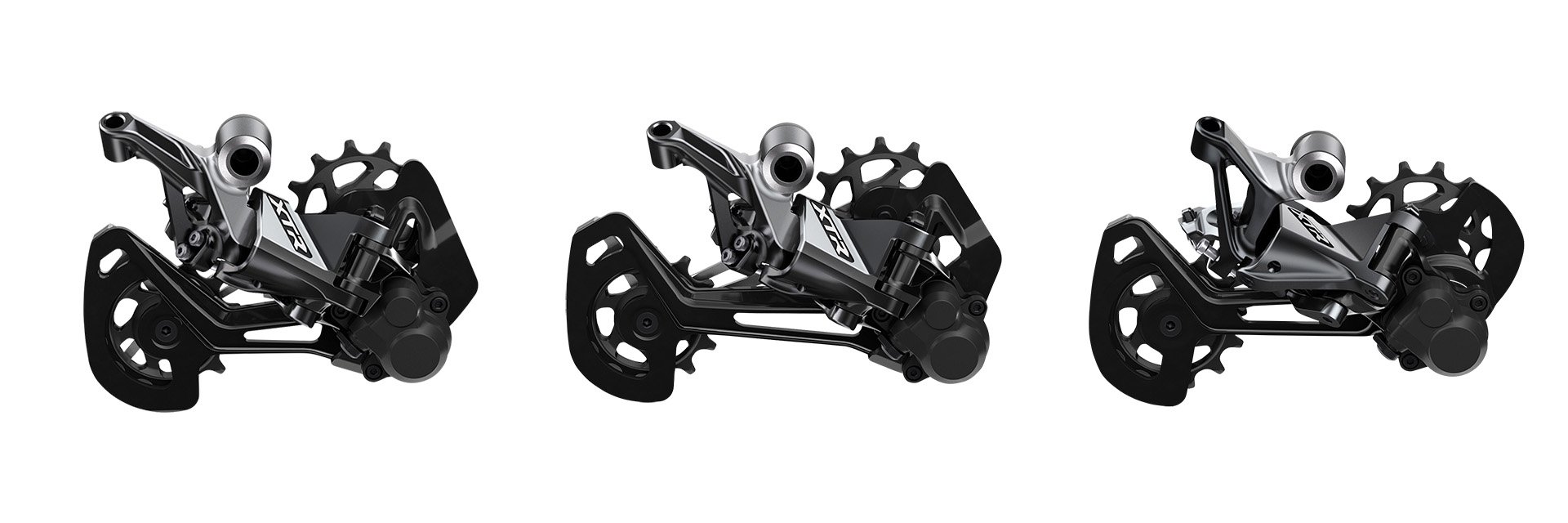
Left to right we have the short cage 12sp XTR 9100, then the long cage and finally the 2x XTR 9120.
Shifters
The front shifter is kind of interesting, with only one lever to engage or release the front derailleur. It will look great in somebody’s museum someday. The rear shifter has more mounting options (14mm slide and 60º rotation) and 35% lighter action than M9000.
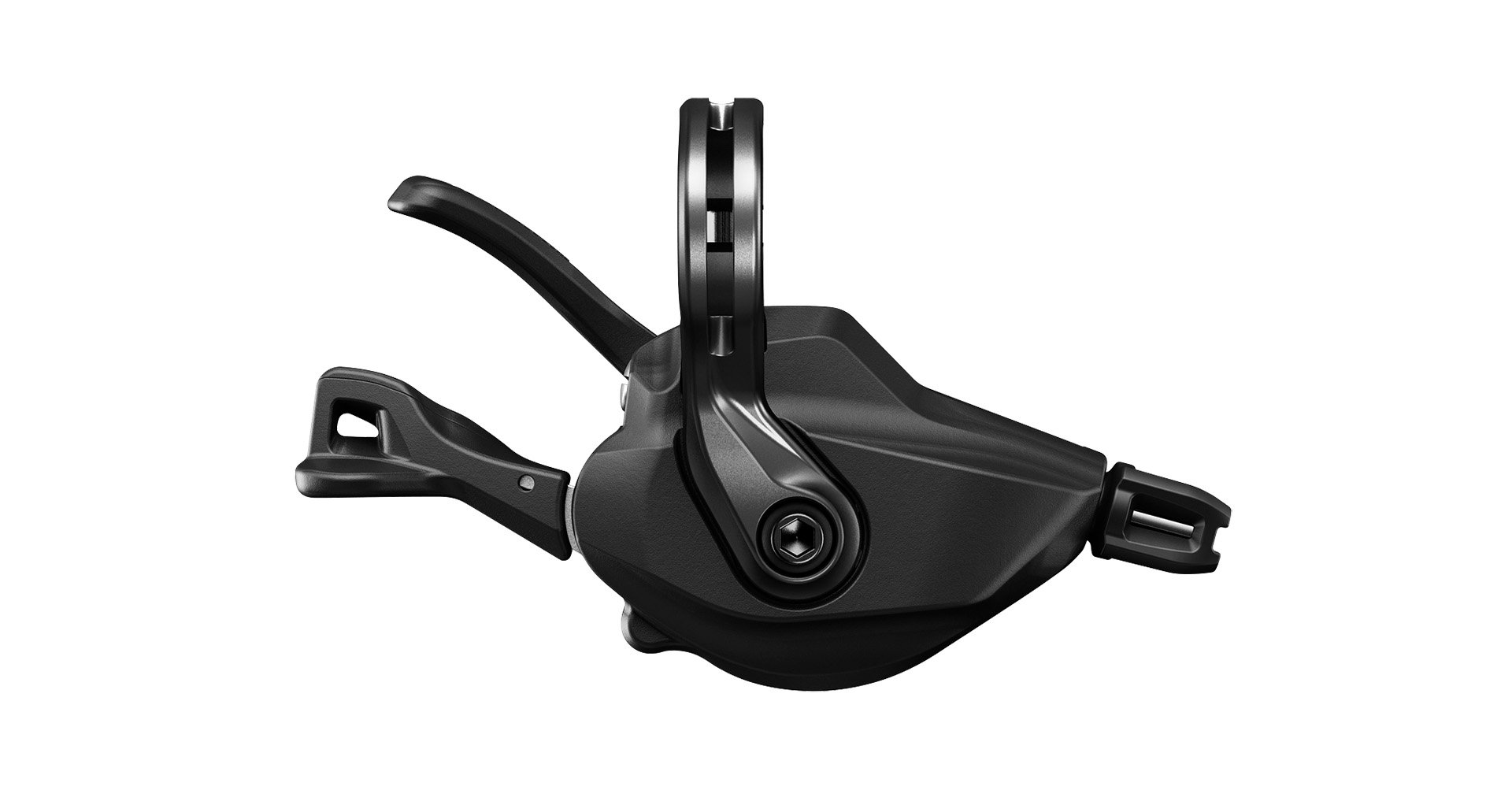
More rotation and lateral movement is good news for the 12spd shifter.
Dropper Remote
Now this is exciting. If you could have any company produce your dropper lever who would you choose? I’d choose Shimano in a heartbeat. This tiny lever mounts directly to the left brake lever of course and it pulls 7mm of cable.
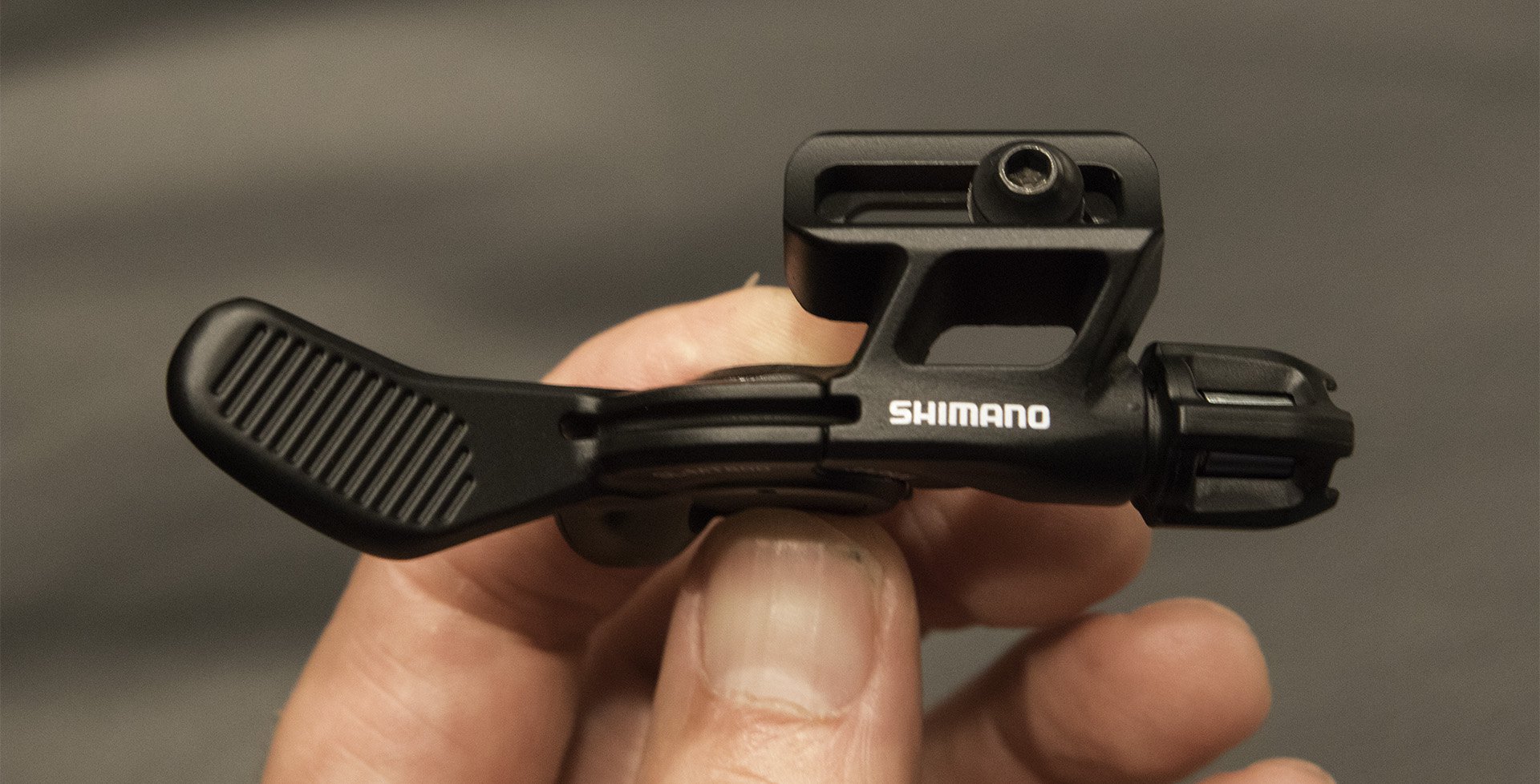
I can't wait to try one of these. It'll be shocking if this doesn't leave virtually every other remote in the dust. Photo - Cam McRae
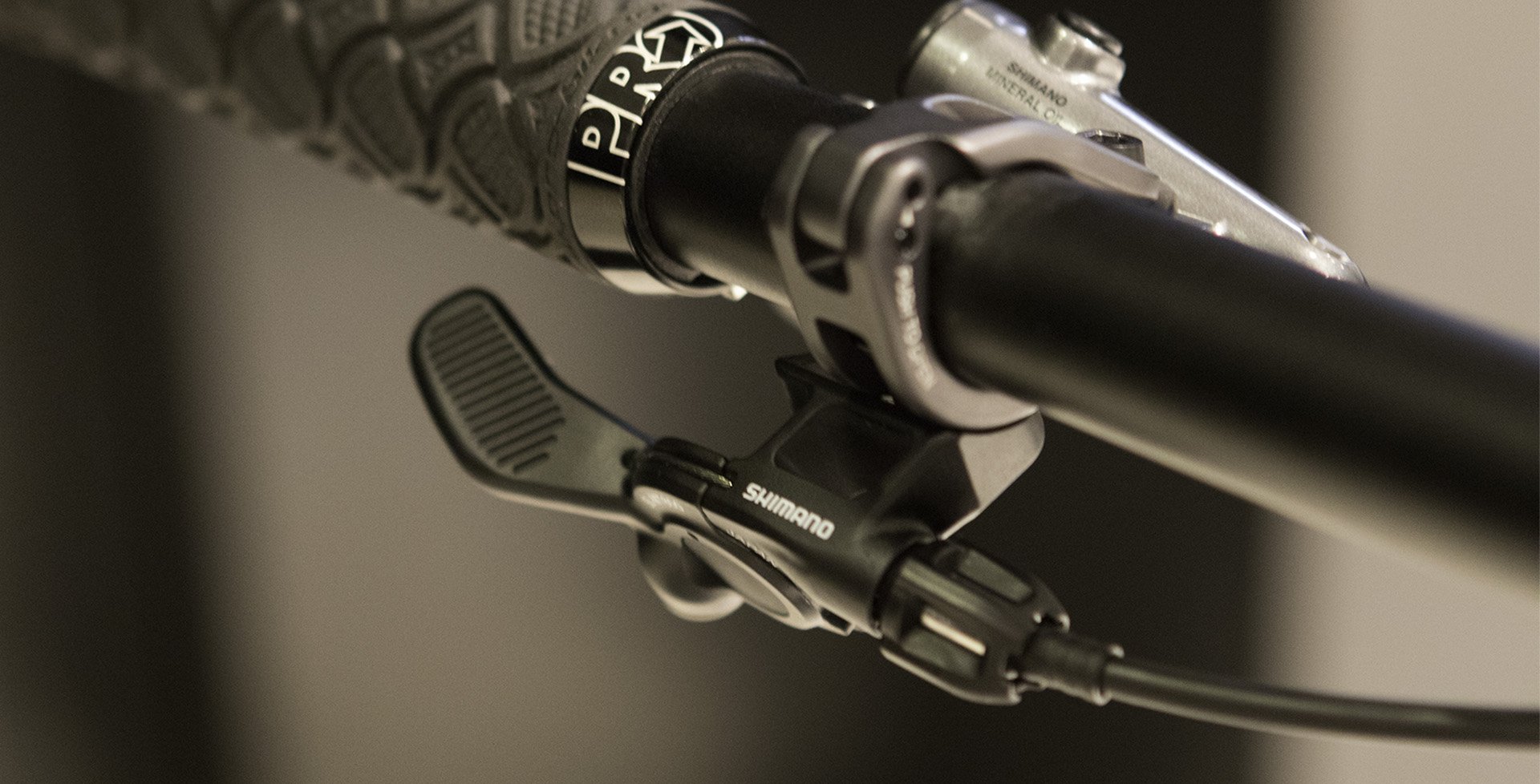
It looks even better mounted. Photo - Cam McRae
Pedals
The trail pedal (now the enduro pedal) has been rejigged to better account for a more rearward cleat placement and sneaker style shoes. The platform has also been widened for stability. They weigh 398g a pair and axle durability is said to have been improved as well. The XC pedals have also have a wider platform and are available in two axle widths for those seeking a low Q-Factor and they weigh in at 310 and 314g.
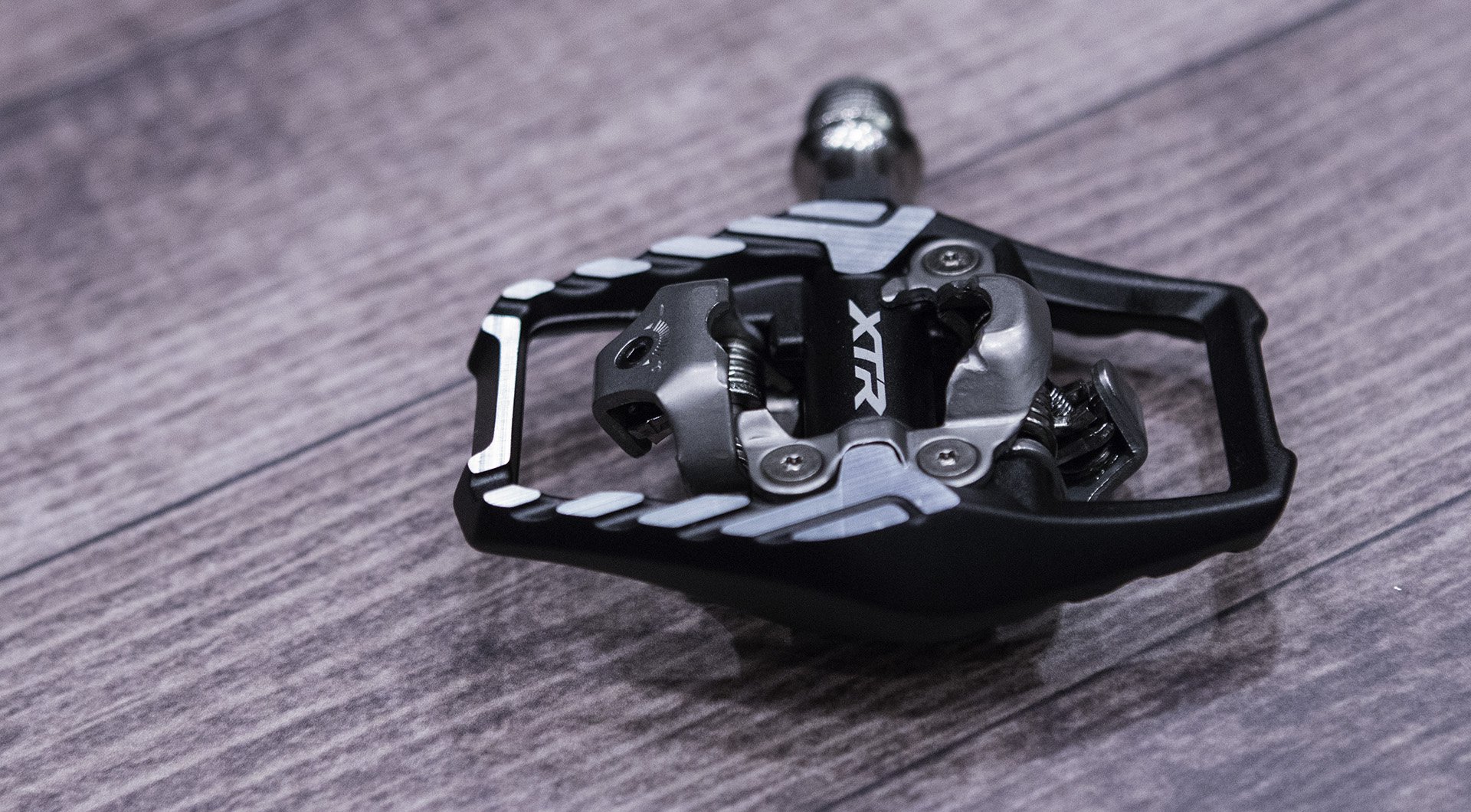
I really like the look of the reworked XTR trail pedal - which seems to be the XTR enduro pedal now. Photo - Cam McRae
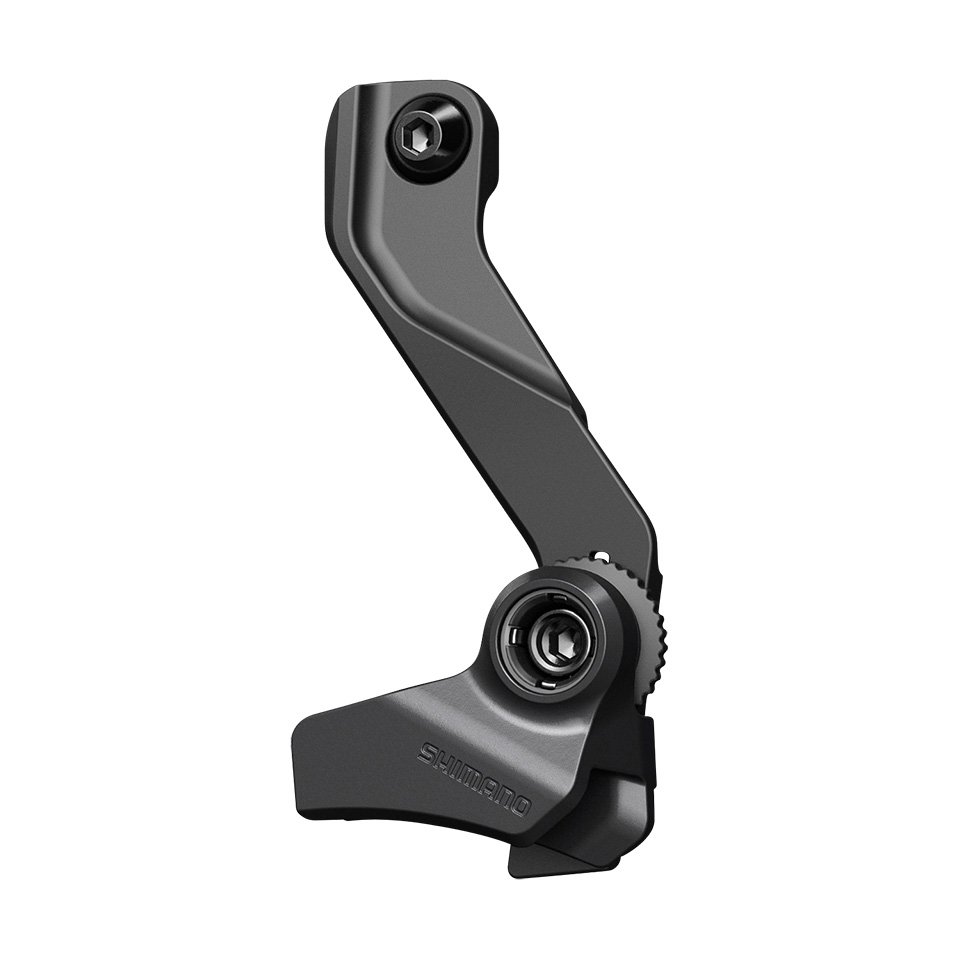
New for 2019 is a low profile chain device that fits multiple standards including ICSG 05, D and E mount.
This One Goes to 11. As well
Shimano polled their sponsored racers to get an idea what was important to them. The lycra set responded with 32% saying ideal gear steps were vital while 68% said range was king. The goggles on the half shell set were similar with a ratio of 34% to 66%. To please everyone Shimano made the rhythm step 10-45 cassette and the 10-51. But there is a third option. The 51t cog is removable and the shifter can be switched from 12spd to 11spd for riders who don’t need to drop down to 51t (Jesse Melamed was mentioned). This saves some weight in the dropped cog, 6 removed links and it allows riders to use the shorter cage derailleur, which saves a remarkable 3g. In total you can drop 80g. The swap also provides better ground clearance, chain retention and reduced chain slap. You can also use an 11spd specific hub for a better spoke bracing angle, but this means you can’t switch back to 12spd unless you have two sets of wheels.
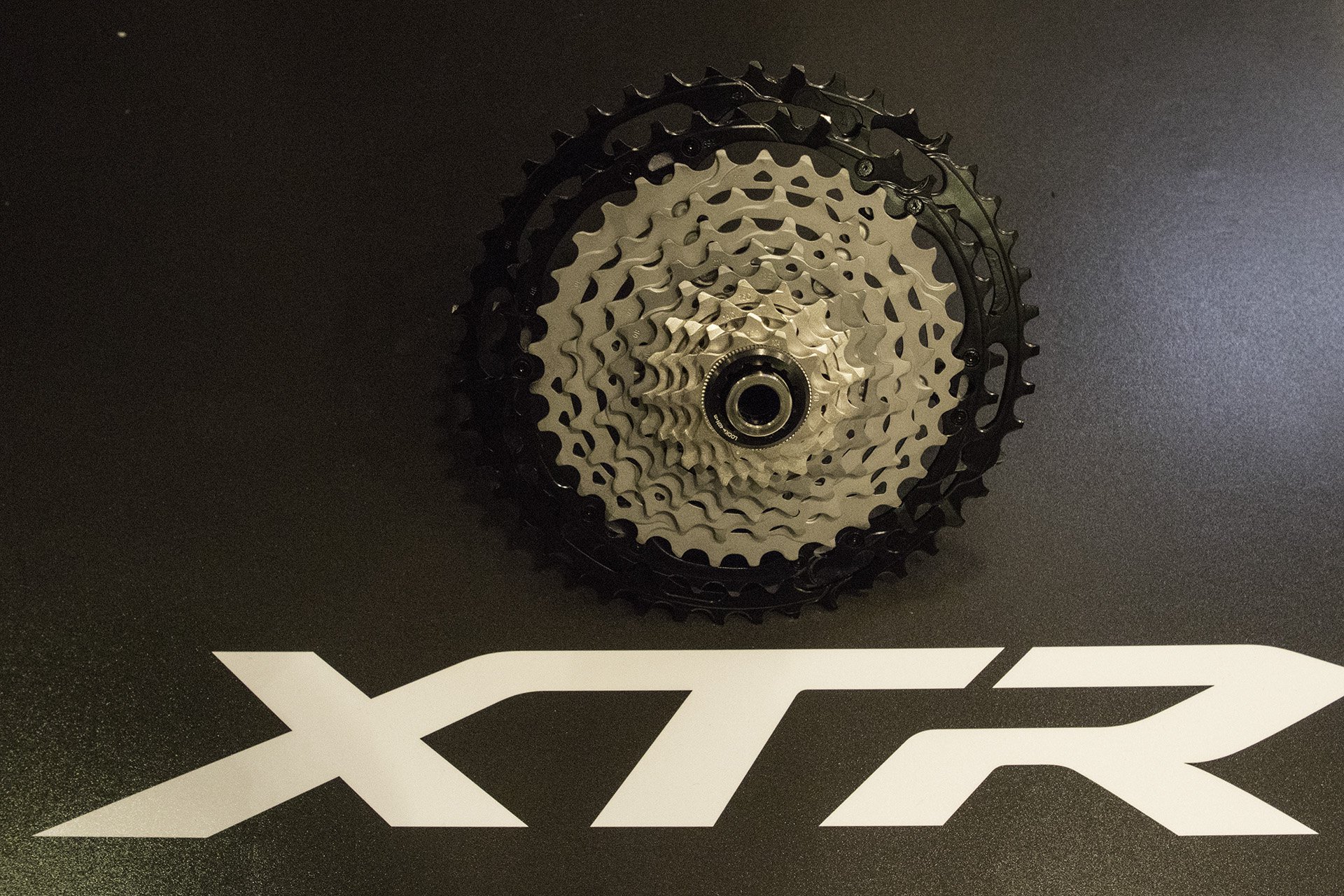
Coming to a weight weenie near you... 11 spd! Photo - Cam McRae
Brakes
There are two brakesets, a four pot set for enduro and a 2 piston version for XC. The enduro set up is said to generate as much braking force as current Saint brakes but with better modulation. You can use Saint pads or the new XTR finned version.
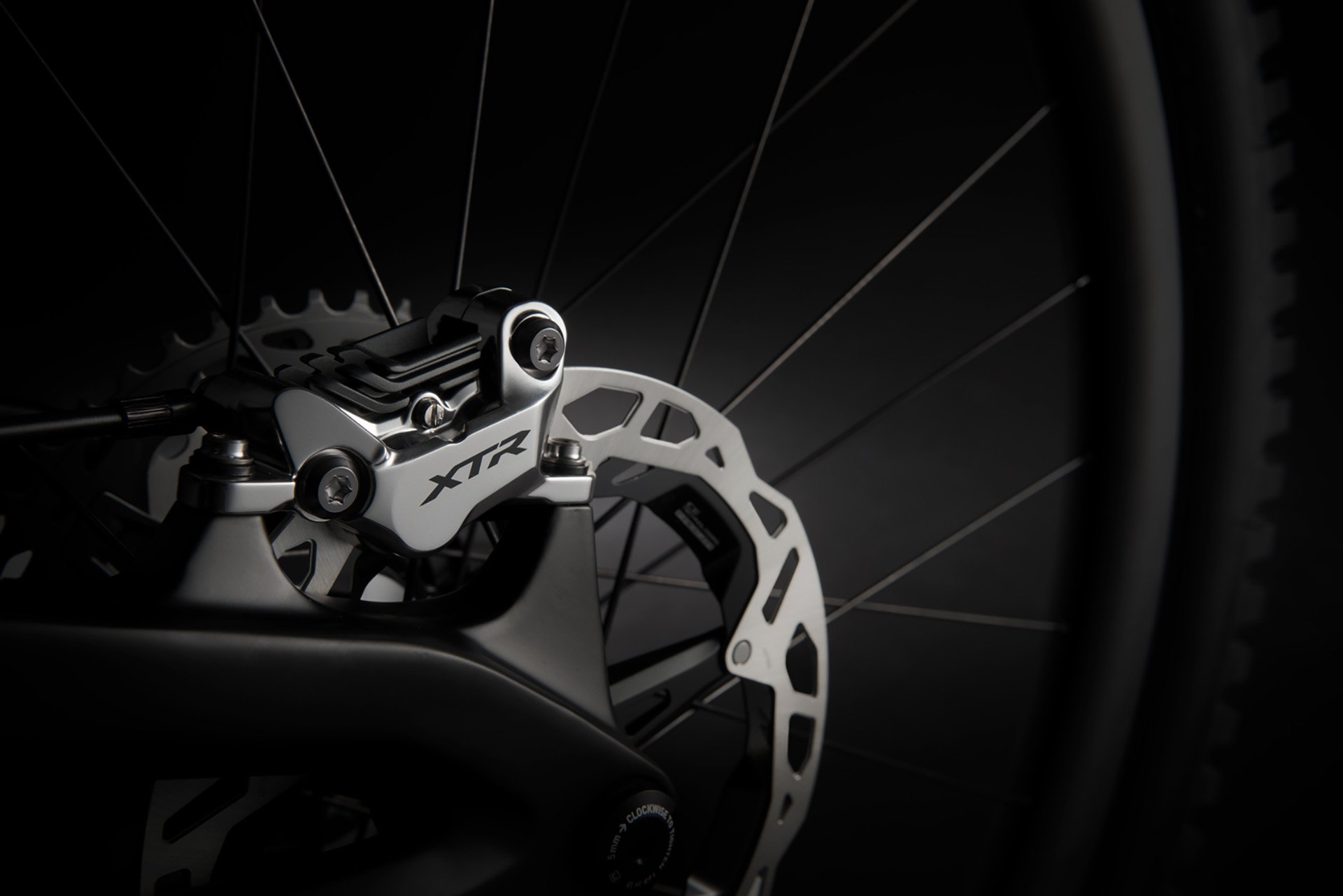
The callipers are nice and compact, despite housing four pistons and packing what is said to be Saint-sized power. .
The brake levers have been smartly redesigned to take advantage of bracing from the handlebar. The clamp moves inboard and the rider facing edge of the lever body rests against the handlebar, significantly improving stiffness. The XC version requires an hex wrench to adjust the reach while the enduro is tool free. Rotors have a new paint surface that reduces operating temperatures by 20% (203mm).
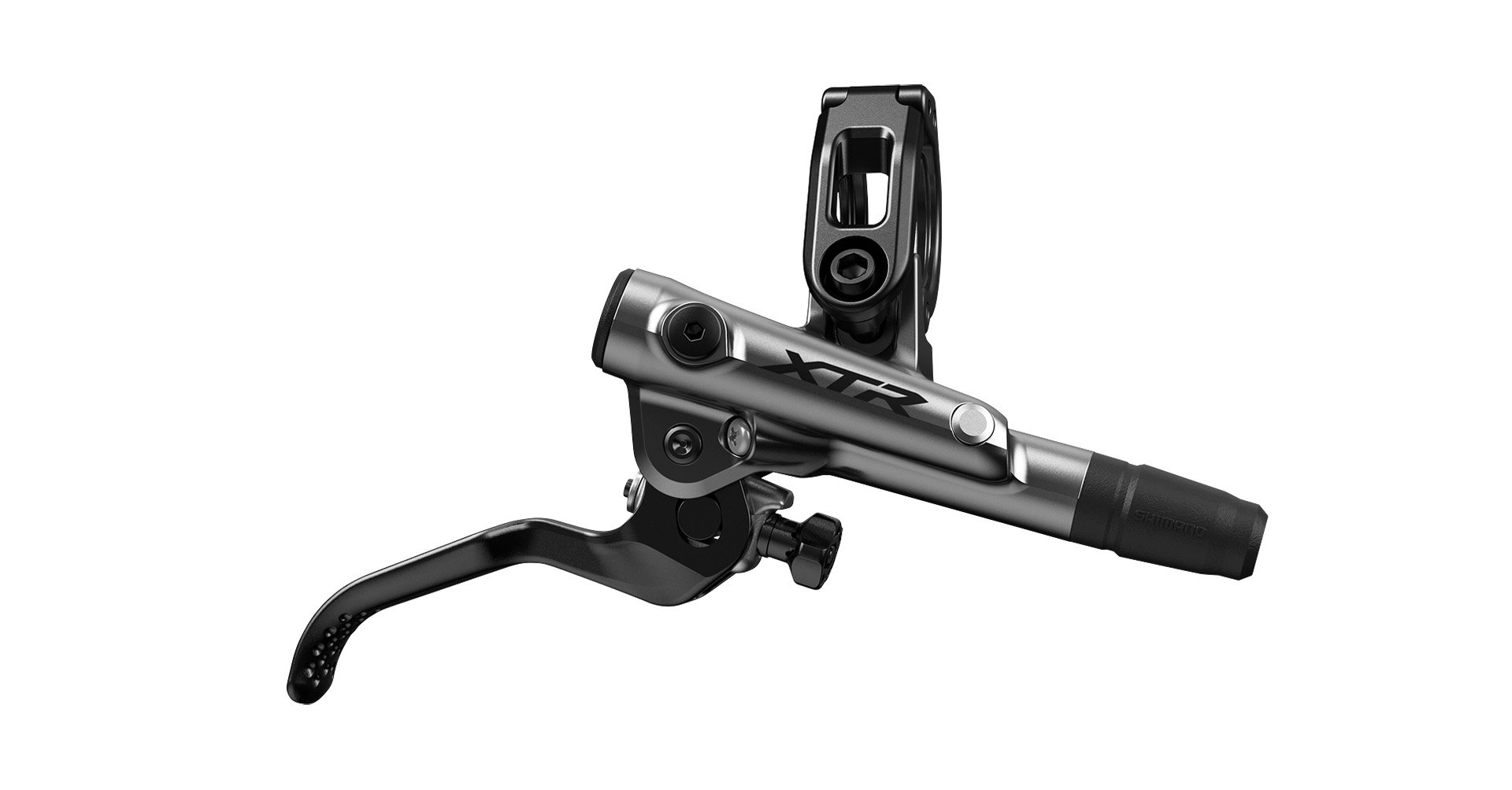
Servo wave lives on but the big story is the way the lever braces against the handlebar.
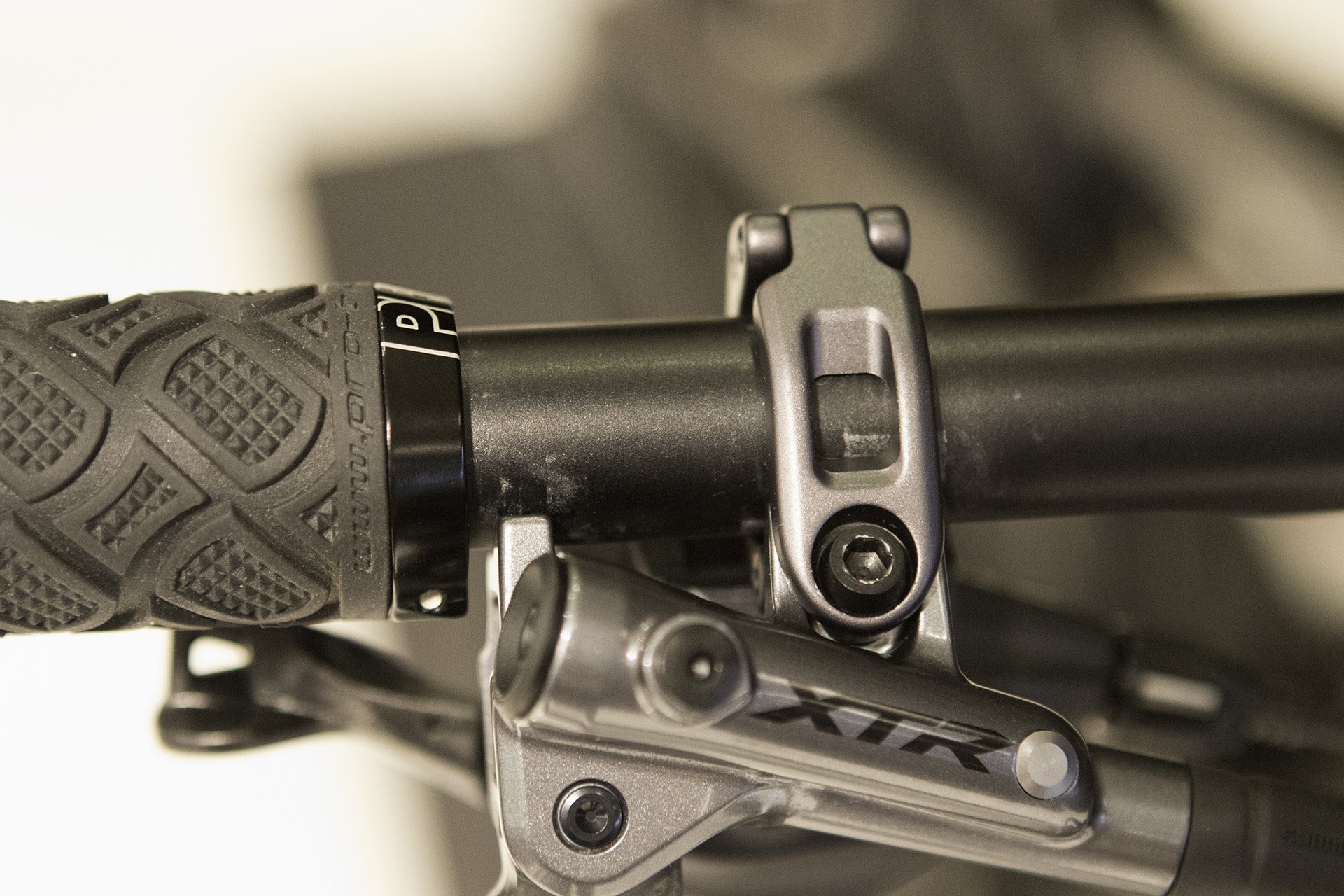
In this photo you can see where the bracing occurs reducing flex and apparently making brake response more immediate.
Money and Mass
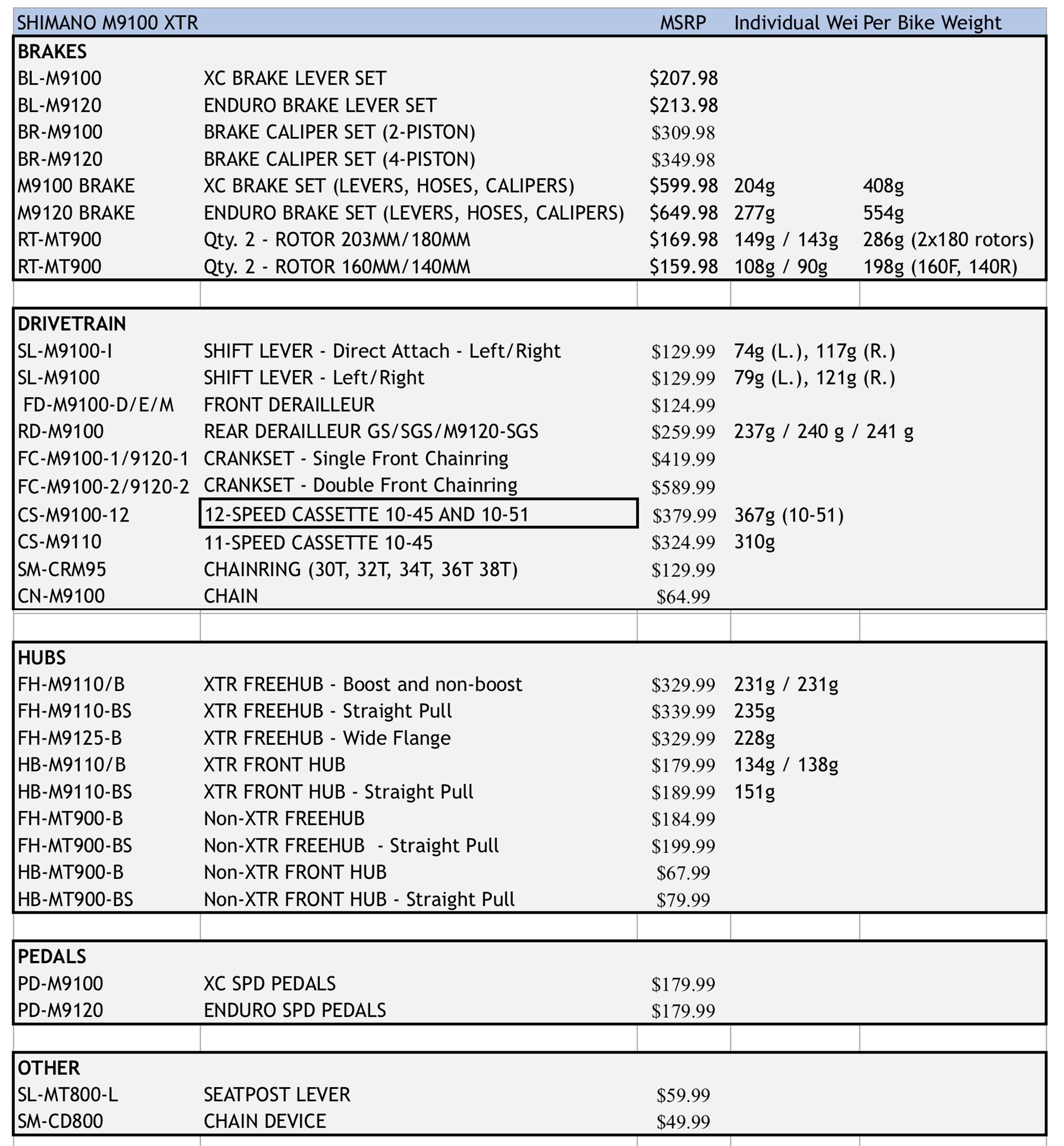
Pricing is a little steep. These package prices exclude chain device, pedals and dropper remote.
- 2665 USD - enduro brakes, entire drivertain and hubs
- 2155 USD brakes and drivetrain - no hubs
- 1385 USD drivetrain less cranks and hubs
All in everything sounds pretty damned good. Boxes are ticked and there is some interesting innovation here, particularly Hyper Glide+ and SCYLENCE. The new brake levers and the dropper remote also look sweet and I expect everything will work extremely well. What’s not to like...
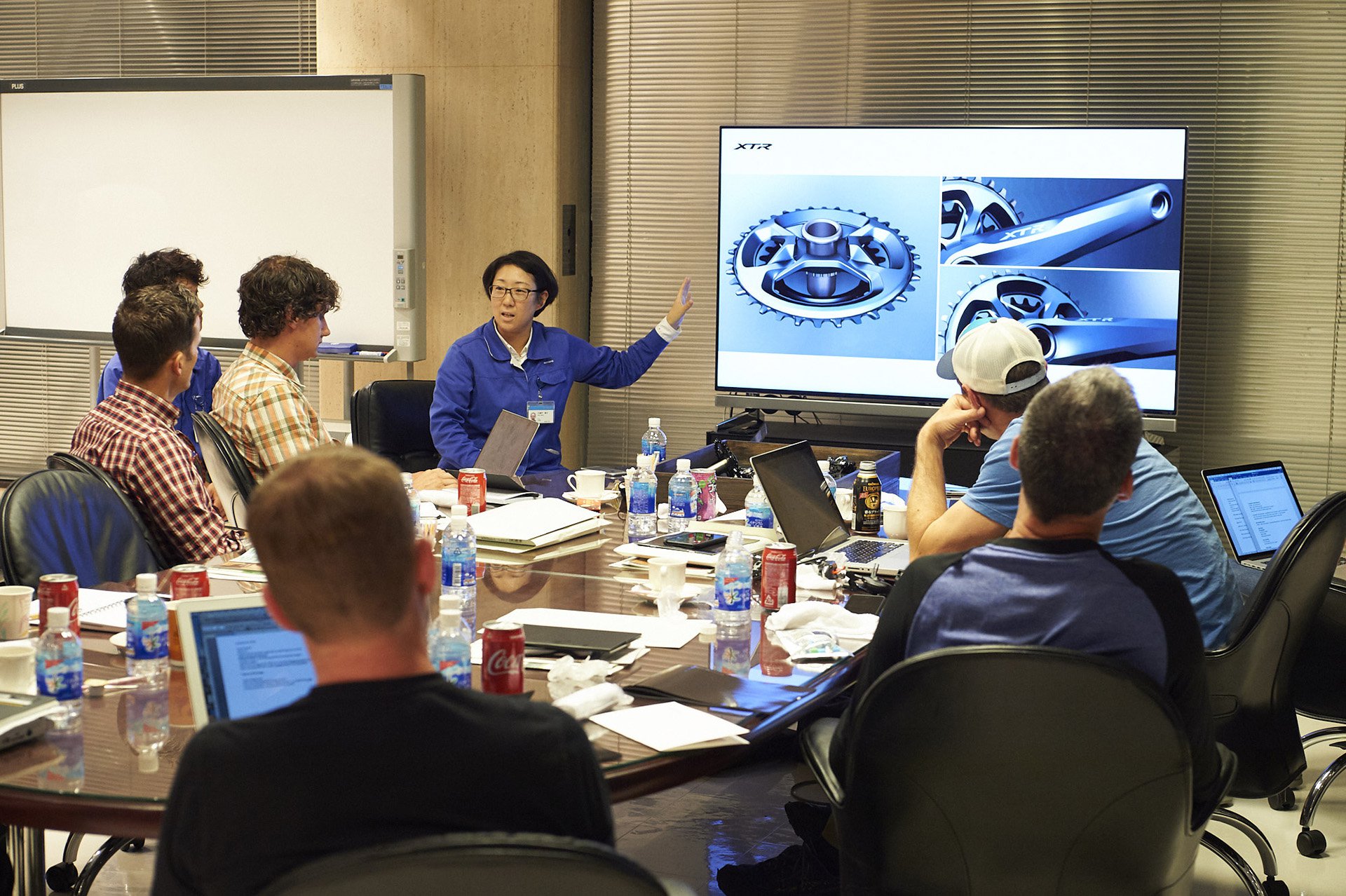
Yoko Oseto was in charge of industrial design for the project and it's clear she had a hand in much of the beauty of the new group. She was the only female Shimano exec we met and was clearly a force to be reckoned with.
The lack of an open source freehub standard, with no suggestion it may be offered in the future, is a puzzling decision that will likely seriously reduce consumer demand in the aftermarket.And I suppose it could affect new bike purchases for people who want to know they can replace a wheel easily in a pinch. If Shimano’s strategy is to go hard for OE spec and to sell some hubs in the process, they will surely see some success, but in the current climate where riders have invested in wheelsets that cost up to 3000 USD, it’s hard to imagine those buyers lining up to have hubs removed from perfectly good wheels to get carbon rims re-laced onto XTR axles.
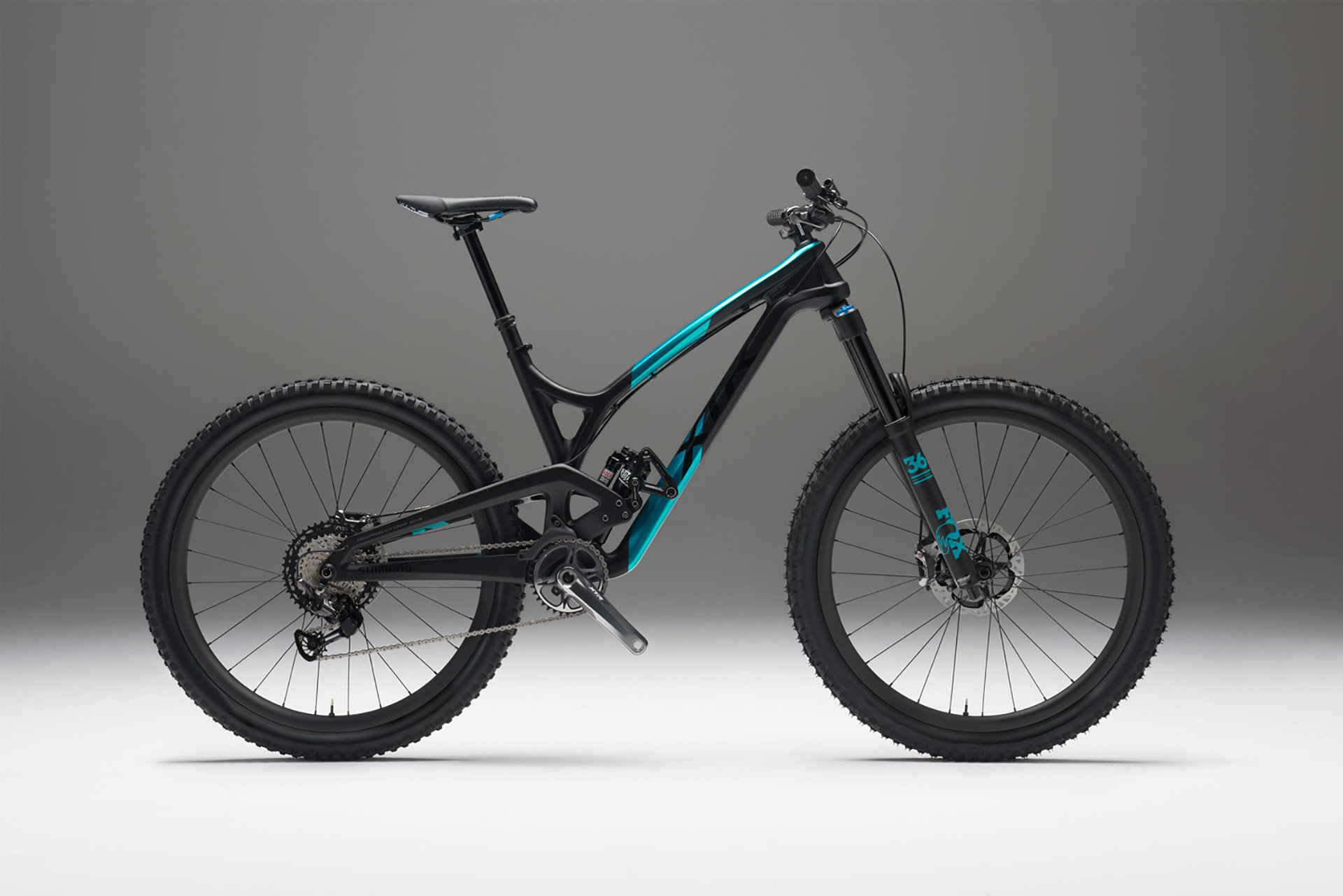
Not a bad setup.
Maybe we'll start seeing rim manufacturers like ENVE, Reynolds and smaller outfits like WeAreOne offering Micro Spline hubs, either from Shimano or DT Swiss, as options for complete wheels. Or perhaps some of the tinkerers in the industry, like OneUp and Wolf Tooth, will begin making Micro Spline compatible retrofits for existing hubs so riders who are happy with everything except their drivetrains could give XTR a try.
Despite what appears to be a few missteps, from where I sit there is much to admire here, assuming it works as advertised. It's also great to see Shimano giving SRAM a run once again.
Now if we could figure out how to start a price war...
If you missed my story on our tour of Shimano's Sakai Intelligent Plant, where these parts are made, click here...
Below you'll find the official press release for XTR 9100.
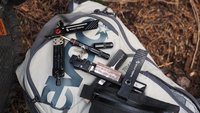

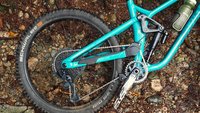

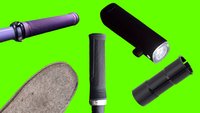


Comments
Nouseforaname
5 years, 7 months ago
I'm too much of a lazy pig-dog to run Shimano hubs. I need the childlike simplicity of cartridge bearings so when my maintenance schedule finally gets round to dealing with my rough as f### hub bearings, it doesn't cost me a wheel build. No sale Shimano - until i can get that freehub body design in something with cartridge bearings - which is a pity as I'm less than stoked on my GX Eagle.
Reply
Cam McRae
5 years, 7 months ago
What is your GX Eagle issue?
Reply
Heinous
5 years, 7 months ago
My GX has been warrantied twice for play at the bolt, first time when brand new. Eventually the main bolt eas replaced with the x0 xx style bolt, which fixed play, but it’s still been poor in really rough muddy conditions - losing the chain from top jockey.
XT and a sun Race cassette fixed it.
Reply
Nouseforaname
5 years, 7 months ago
I’ve bent two cogs on the cassette (mid block) - never had that happen in 25 years of mtb.
Shifting is clunky and I miss the double up shift of Shimano.
Reply
Kos
5 years, 7 months ago
Crazy proprietary freehub stuff. Probably works great. Could be a market killer, BUT, this is XTR. Anybody want to bet on XT being 11-51 and compatible with the old freehub? Me neither, but if they make XT this difficult to "hub", big blunder.
Individual cog sizes for the two cassettes would be awesome.
Also, any chance cog spacing remains the same as SRAM? If so, I'll just continue with Eagle cassettes on the many wheels I already own, and switch quickly to Shimano shifters and derailleurs.
Oh, wait, September availability. N/M on the quickly part.
Reply
Shoreboy
5 years, 7 months ago
Why not keep everything at 11-51? I know, I know, they tell us they need to be 'innovating'. I guess the need for that one extra tooth to say 'we have more range' outweighs the rediculousness of needing an entire new freehub for that one extra tooth.
Reply
UFO
5 years, 7 months ago
This xD vs. Shimano discussion is interesting. I've been intrigued by how few xD cassette options there are on the market however, especially for 11 speed, given the open-ness of xD.
I'm aware of only e13 offering an aftermarket option, priced at the high end of the spectrum. I can see why SRAM hasn't offered up a wider range 11spd option in wanting to protect the Eagle groups. But I'm sure the aftermarket could churn up an affordable xD 10-44/46/48 for 11 speed, especially if Sunrace can do an 11-50 on the existing Shimano freehub.
Reply
Daryl Naskale
5 years, 7 months ago
XD was never going to be the new universal standard, it is too limiting for technical reasons even if it is wide open. But there are other options. For example Garbaruk also offers aftermarket cassettes for XD. They are also high end options, but fairly priced. e13 and Garbaruk also reveal part of the problem with XD, it's not a very good freehub design. The e13 cassette requires a complicated structure and installation, and they have had difficulty making it quiet and reliable. Garbaruk makes their cassettes similar to SRAM from a steel billet. They make versions for both Shimano and XD freehubs, the difference being that the Shimano ones are limited to an 11 tooth smallest cog. But otherwise very similar in construction. But because of the limitations of XD, those versions are costlier and much more complicated to install. And they changed the design to use 2 lockrings to make it more secure. SRAM's own cassettes would probably work better if they were changed to work with the new Shimano design than they do currently, XD has never been known for ease of install. The new Shimano freehub should prove to be a superior and more versatile design, I just hope Shimano has plans to open it up.
Reply
Alex D
5 years, 7 months ago
> I've been intrigued by how few xD cassette options there are on the market however
https://docs.google.com/spreadsheets/d/16C3Rz6qmzmurSNd-L3IeMSFukkBFV6D1DRbfS59EDrE/
There are over 20 cassettes for XD besides SRAM's. Most are 11-speed. How many do you need?
Reply
Andrew Major
5 years, 7 months ago
I had never heard of the Ingrid cassette before. I mean sure it's $$$ but regardless it is a beautiful thing.
Reply
Daryl Naskale
5 years, 7 months ago
It's a very short list if you eliminate the boutique CNC art.
Reply
Bogey
5 years, 7 months ago
It’s an even shorter list if you get rid of cassettes that cost over $300. Ridiculous!
Reply
Alex D
5 years, 7 months ago
Fair. I'll concede the larger point that XD isn't suited to cheap cassettes. Even the XG-1150 runs north of $100. Pinning the sprockets together is apparently cost-prohibited.
I do think for bikes at the XT and XTR level, though, XD is very competitive. (That's really where XD starts anyway; GX lines up with XT.) Garbaruk's 10-46 has more range and durability than Shimano's new XTR 10-45 11-speed, at less cost and similar weight.
Reply
Daryl Naskale
5 years, 7 months ago
Micro-Spline will be well suited to all price points and construction methods. Based on their current offerings, if Garbaruk is able to make a Micro-Spline version of any of their 10t cassettes, they will be cheaper, simpler and lighter than the XD versions. If a 9t can fit, this goes double for E*13. If Shimano doesn't open the standard all the way up after 12 speed XT drops or sooner, they are really missing an opportunity to take a bloody chunk out of SRAM.
Reply
Mbcracken
5 years, 7 months ago
If the micro-spline (which I am sure will eventually become more widely used model of freehub) helps free hubs last a bit longer for my clyde legs...I am all for it. I like Shimano stuff and usually go thru about 1.5 years per freehub.
Cheers,Mike
UFO
5 years, 7 months ago
My ask is a Sunrace type xD competitor, cheapish and offers a better range at 11spd. I mean, I'm sure people are happy to pay $150 for a 10-46/48 pinned xD cassette vs dropping the coin on full Eagle.
Comparatively an XT 11-46 retails at ~$150, you can get any Sunrace 11 speed cassette for that.
Reply
kylemciver
5 years, 7 months ago
I'm more curious why the didn't mention SRAM, put a Fox fork on the Evil and left the RS rear end.
Reply
Bogey
5 years, 7 months ago
Definitely a major oversite to leave that RS shock on the Evil. At very least they could have de-branded it like the rest of the bike.
Reply
Alex D
5 years, 7 months ago
So HG+ delays the upshift? I'm not sure how I feel about that. It also seems keyed to some very tight physical tolerances. What result when the system has 500 miles of wear and cruft? No one likes the endless skipping of an almost-upshift.
To me, the hub is the most exciting part of this group. Silent, light, presumably strong and reliable, and decent engagement? Sign me up. I still think SRAM has better cassettes (one-piece steel > titanium, the 11S 10-42 undercuts this new "light" XTR 10-45 by 50g), but ditching the freehub noise is even more compelling. Compelling enough that a surprising number of folks stomach P321's endless grease issues and the Onyx anchor to get it. Let's hope it doesn't stay an XTR-only feature.
Reply
whatyouthink
5 years, 7 months ago
onyx hubs get a lot of crap for their weight. but i think the ABSOLUTE instantant engagement far outweighs the drawback of weight. And mine have been bulletproof.
Reply
Andrew Major
5 years, 7 months ago
Same thing with True Precision; silent and instant is glorious in my mind and worth the weight - on a hardtail.
I’m not a weight-weenie by any stretch when it comes to overall bike weight, but we are talking about a fair chunk of unsprung weight so I can appreciate folks preferring much lighter hubs with almost as quick engagement for dual FS bikes.
Reply
Alex D
5 years, 7 months ago
Everyone has their priorities. Weight ranks high on my list. Trail bikes have ballooned so much (usually for good reasons; I'm not giving up my dropper) that it's not unusual to find models north of $5K that crest 30 pounds. Adding nearly half a pound to the rear hub alone is, to me, no small compromise. I think the Onyx hub is brilliant, but I'll satisfice with "good enough" engagement to save 200g.
Do you notice any flex after engagement? Some folks have posted videos showing a surprising amount of crank movement without corresponding wheel rotation.
Reply
Andrew Major
5 years, 7 months ago
I notice the sensation you are talking about with the Onyx (sprag clutch) - if I want to - but not with the True Precision Stealth (roller clutch). I know two people who have tried both and say the same.
I know a surprising (to me) number of Onyx owners (Nobl wheel spec mainly) who say they don’t notice it and LOVE the hubs. I know of at least two guys who sold their wheels on because it drove them nuts. Weird human stuff right?
Totally get what you’re saying re. Bike weight. Happened to have a naked True Precision / Race Face Arc 30 in my hand the other day vs a naked Industry Nine rear on a carbon Reynolds rim and it’s a huge difference. I don’t care vs silent/instant on my SS but I can appreciate why many riders do.
Reply
Daryl Naskale
5 years, 7 months ago
The wind up is there, but I was riding and loving my Onyx hubs for a while before I noticed it, and only because I saw it mentioned in a forum post and tried it for myself. If you stomp the pedals against the brakes, there is definitely a visible winding up of the sprags, but it is like loading energy into a spring, it gets returned instantly as the peak torque comes down. So unless you are particularly sensitive to it, or you ride a really heavy, very low geared bike, it is more of a feature than a problem because it gives a very nice, smooth take-up to the instant engagement. The Onyx hubs have also proven to be very strong, super smooth and completely reliable. I am intrigued by the new XTR hubs because silence is not optional for me anymore, and they look to have good engagement and be strong. So it will become a matter of weighing the benefits of the sprags versus the lower cost and weight. And while Onyx has a lighter weight version in the works, it is never going to get down to where these are. And of course the availability of Micro-Spline freehubs will be part of the decision.
Reply
Andrew Major
5 years, 7 months ago
Currently writing a long term review of P321 hubs and curious about your “endless grease issues” comment.
I had issues with the stock grease early in my review, flushed it, replaced it with Dumondetech freehub oil and they been amazing since. It was a ten minute fix.
The hubs have been coming stock with oil instead of grease for months.
...
The hub design is very interesting but I don’t see it confirmed anywhere if they are using cartridge bearings or still insisting on cup-and-cone which makes them a no-sale for a lot of riders.
I’ll bet by the time we can buy XTR, or more importantly XT, every manufacturer will have a compatible freehub body [insert joke: except Chris King, theirs is coming in 2035]. Shimano wanted to keep specs under wraps until now but there is no way they’re going to give up a huge volume of cassette sales to sell a few hubs.
Reply
Cam McRae
5 years, 7 months ago
I can confirm that is cup and cone.
I personally think it’s great if 1)you know how to take care of it and 2) you do take care of it.
Reply
Andrew Major
5 years, 7 months ago
Thanks, totally agree with a third caveat: 3) Good small parts support for wear items (cups + cones) is a must.
Reply
Alex D
5 years, 7 months ago
I periodically tune in to the P321 thread on MTBR. It's a parade of "it worked but now it doesn't, but they're sending out parts, except they're moving so they're busy, but really it'll be good this time." The most recent successes seem contingent on the use of that (or some other) specific and expensive lubricant.
While I'm sure there's selection bias at work in the forums, this has been going on for years; it's clear they're beta-testing on well-heeled customers. Can't say that about Shimano. I expect this hub to be just as bulletproof as the vast majority of their other products.
> or still insisting on cup-and-cone which makes them a no-sale for a lot of riders.
Cups and cones deal with lateral loads a lot better than cartridges. Easy to maintain, easier to seal, no bearing interface to creak. All desirable on a mountain bike. How much of that 'no-sale' is marketing perception?
> there is no way they’re going to give up a huge volume of cassette sales to sell a few hubs.
I wouldn't venture to guess how product decisions work at that company. This stuff looks brilliant, but it's been what, five years since XX1? There's a combination of lethargy and paternalism at work here that may not have been banished from their ranks. Opening the standard is what a scrappy company would do. Shimano reminds me more of IBM circa-1990.
Reply
Andrew Major
5 years, 7 months ago
Alex, as with the “endless grease issues” comment I think you’re being a bit loose with the hyperbole here.
Project 321 has been producing their own hub internals for less than a year. Before that they were just stock Industry-9 internals.
As with any pawl hub you can just run mineral oil if you prefer. I’ve also had great luck with really light synthetic oil. I prefer Dumondetech but there are a range of products that work fine including cheap sewing machine oil.
I don’t know why anyone would needs parts re. flushing grease / installing oil. I guess if I kept riding sticking pawls I could have damaged the internals.
Anyways, P321 is aware that the grease was a F-Up. What works in one local or a certain set of testing conditions doesn’t work everywhere sometimes. Challenge of being a small company etc.
I’m stoked that you’re stoked on the new Shimano hubs but I think it’s possible to do that without exaggeratedly shitting on other products.
Reply
Alex D
5 years, 7 months ago
> Challenge of being a small company etc.
My interest is the product. Whether it comes from an upstart or a monolith isn't relevant to me. I'm not a venture capitalist, I'm an end-user, and as an end-user, this looks like a work in a progress.
http://forums.mtbr.com/wheels-tires/new-project-321-rear-hub-leaking-oil-now-sounds-much-louder-1042569.html
That's not acceptable for a $400 hub. I'm thrilled it's performed for you, but I'm not convinced your experience is universal.
Reply
Andrew Major
5 years, 7 months ago
Thanks for the link; I’ll definitely check it out.
Reply
Luix
5 years, 7 months ago
Try to source replacement cones and/or cups in a third world country and then come talk to me about durability. I can get replacement bearings for my hubs easily, not likely with cones and cups. I have seen XT hubs cannibalized or just thrown away because their owners couldn't find a way to keep them rolling after a piked ball bearing destroyed the surfaces.
Reply
ZigaK
5 years, 7 months ago
In my experience, and I have plenty of experience, bearings of XT hubs don't need replacing, because the ratchet fails long before. But the failing intervals are just long enough and the price so low, I can't scrape enough vitriol to buy a better hub such as dt 340 or something from hope. And as an added bonus, with the help of Sheldon Brown I became a pretty 0k wheel builder. I usually lace a wheel and true it just as the Nightly Show with Larry Wilmore draws to an end. It's a long interval.
Reply
Alex D
5 years, 7 months ago
They might try replacing the grease when the hub starts to sound like a rock tumbler. It takes a *lot* to score the races, particularly the inner one. If you can't get Shimano parts where you are, I don't know how you're getting quality bearings.
Reply
earle.b
5 years, 7 months ago
If they don't open up that new freehub body asap it will be their biggest blunder in decades.
Reply
Dave Tolnai
5 years, 7 months ago
Totally, 100% agree. I'm absolutely baffled by their insistence on not using a common standard that just happens to have been developed by a competitor. But to lock down your own new competing standard? And give two wheel brand options? I just don't understand this at all.
Reply
earle.b
5 years, 7 months ago
I have no issue with the new standard. I can see why they have decided to not use the SRAM XD Driver. Every major hub manufacture should have had CAD files to this new design in their inbox weeks ago and Shimano encouraging them to get them into production.
Reply
Luix
5 years, 7 months ago
XD is an open standard. The new Shimano freehub is only available under licensing. That's why only DT will be producing compatible ones.
Reply
Cam McRae
5 years, 7 months ago
Yep. That was in the article.
Perry Schebel
5 years, 7 months ago
the lightweight silent clutch mechanism does look sick. perhaps the patent references dt's star ratchet, thus locking things down. would love to get back on board shimano. that said, not at the xtr price point. hoping for the xt trickle down sooner than later.
Reply
Shoreboy
5 years, 7 months ago
Was the XD driver an open standard from the get go? I know it is an open patent now, but was it an SRAM only deal for the first little while? The google failed me in finding this information. I wonder if they are keeping it 'exclusive' for the first little while for XTR, but will open it up when XT gets rolled out.
Reply
Andrew Major
5 years, 7 months ago
I think the real question with the XD Driver/cassettes is “are they compatible with motors?”.
If the answer is “no!” then e-bikes would have meant Shimano wouldn’t even consider using the standard.
Reply
earle.b
5 years, 7 months ago
Boom.
Reply
Cooper Quinn
5 years, 7 months ago
Well someone went and said it.
Reply
Alex D
5 years, 7 months ago
There is no "open patent." A patent allows you to enforce a licensing agreement while preventing the sale of substantially similar inventions. If that licensing agreement has few restrictions, the invention might be considered "open" to use. Only when the patent expires and the invention enters public domain is it truly open.
XD is, and has always been, licensed at no cost to pretty much anyone who promises to follow the standard.
http://www.xddriverbody.com/
The problem with it from Shimano's view (besides NIH syndrome) is that (inherently, because it's a standard) there's not much engineering flexibility to modify it, and they can't use their preferred method of manufacturing cassettes. I'd hoped they'd give the one-piece thing a shot, but they doubled down on titanium.
Reply
Brad_xyz
5 years, 7 months ago
@earle.b Totally agree.
If other manufacturers are not able to make compatible freehubs (Like my 'go to' Hope) I'll likely keep using something else even once these 12 speed Shimano options trickle down to XT. Honestly, I would have been happy with a slightly wider 11 speed option without the current big jump to 46T so for now I'll be sticking with shimano 11-42T with the OneUp or Wolftooth gear upgrades or maybe looking at some of the other 3rd party 11 speed cassette options.
Reply
Perry Schebel
5 years, 7 months ago
i've been eyeing up the sunrace 11-50 option. ~$75cad out of germany. not light, but at that price...
Reply
Cam McRae
5 years, 7 months ago
Dual control?
Reply
ZigaK
5 years, 7 months ago
:)
I actually rode a mtb equipped with dual control and it was surprisingly nice.
Reply
JT
5 years, 7 months ago
It's not their first time holding off licensing a freehub body pattern. When Dura Ace first went to 10 speed is the most recent I can recollect. I'll bet in a year or two it'll be almost open source. They'll likely still hold the reins on lockrings, as they did with their cassettes and Centerlock design.
Reply
earle.b
5 years, 7 months ago
If they wait that long there will be many many more nails in their coffin for the trail bike market. They need a GXeagle competitor like 12 months ago. Waiting to open up the freehub and waiting to trickle down to XT and SLX will not help them.
Reply
JT
5 years, 7 months ago
True, at least in the eyes of us end user types. They're a slow, deliberate company though. Rare is is it that one of their high end goods as manufacturing issues. We may not like their pace of development, but it's hard to argue with the success rate. (FWIW, I ride Campy on the road bike so I'm not a total fanboi)
Reply
Rob Gretchen
5 years, 7 months ago
Shimano's arrival to 12 speed is anti-climatic...at least to me. I have nothing but praise for the GX and X01 Eagle drivetrains on my bikes with no plans to revert back to Shimano anytime soon.....
Reply
mobilelegends
4 years, 10 months ago
This is a great post. I like this topic.
free pc games
Reply
jack102
3 years, 9 months ago
I couldn't agree more with your post, please give us a call if you're in need of rubbish removal services.
House removals Swindon | Landscape Gardeners |Local tree service
Reply
jack102
3 years, 11 months ago
This is such a helpful article, thank you for writing it.
Jack
Removal companies Stockport | Waste Removals | Commercial carpet cleaning
Reply
jack102
2 years, 4 months ago
Wonderful thread and post, if you are ever in need of rubbish removals, office cleaning or trace heating - see my links below.
How to office clean effectively
Tips on rubbish removals
Electrical Trace Heating Installation | Trace Heating Installers
Reply
Please log in to leave a comment.